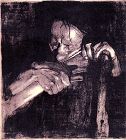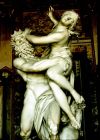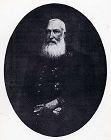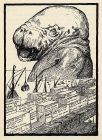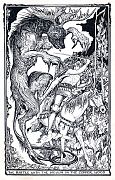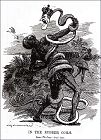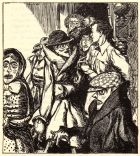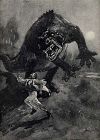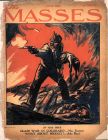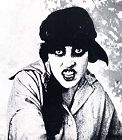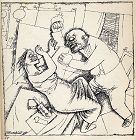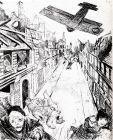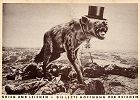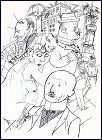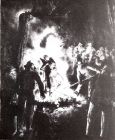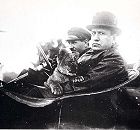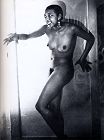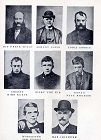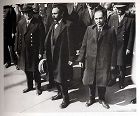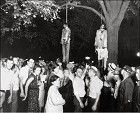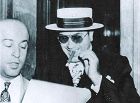Found Pages: The Remarkable Harold Ernest (“Darcy Glinto”) Kelly, 1899–1969.
Violence, Inc: Part 1, 1899–1928
- Part 1. 1899 to 1928
- Part 2. 1929 to 1939
- Part 3. 1940 to 1945
- Part 4. 1946 to 1955
- Part 5. 1956 to 1975
For a general introduction to Kelly, see Introductory.
For a would-be complete chronological bibliography of works by or attributed to Kelly, see BioBibliographical.
Introduction
And you all know security
Is mortals’ chiefest enemy.
Between 1900 and 1913 no fewer than forty heads of state, politicians and diplomats were murdered, including four kings, six prime ministers, and three presidents.
Niall Ferguson, The War of the World (2006), p.73I
The Ariadne’s thread in this 67,000-word five-part chronological medley is violence. A thread is necessary.
If you came across books by Lance Carson, Preston Yorke, Gordon Holt, Darcy Glinto, John Preston, Buck Toler, Hank Janson, Clinton Wayne, Harold Kelly, Bryn Logan, and Eugene Ascher in a used-book bin, there’s no way in the world that you would guess that they were all by the same hand. The Glintos and Tolers, maybe, and some Carsons, Waynes, and Logans. But after that? No way.
But what with the thirty-eight (attributed) Glintos, Tolers, and Jansons (crime), and the twenty-three attributed Carsons ,Waynes, and Logans (Westerns), the preponderance of Kelly’s books are ones in which violences are more or less central.
Which is not the same thing as saying that they are all violent books.
II
A work in which a lot of listable violences occur (eleven fatal shootings, three stabbings, etc) may not feel violent. Another, with very few, may invite the term instinctively.
A major difference is likely to be that in the latter we are drawn into states of consciousness out of which violent acts can all too believably issue. And we enter the suffering bodies of victims.
Victims. Violators.
How violent a work feels can depend on how disturbing the most violent of the violences in it is. A boundary has been breached. If this can happen, what else may happen?
Conventional protections have ceased operating.
The violences in Kelly’s books are serious ones. The risks run by characters are real, with no certainty of a happy outcome.
Kelly doesn’t write capers.
III
I have provided fuller descriptions here of what happens in most of Kelly’s books than are contained in “BioBibliographical.”
I’ve also described numerous violence-related works, both fictional and factual, by other writers, and a number of movies. Almost all the works would have been available in Britain, somewhere, to some people, at the time.
More information about some of them is provided in the Notes and Sidebars.
Absent almost entirely, though, are Westerns by other writers. I simply haven’t read enough of them.
IV
James Hadley Chase figures prominently here for a bit. Between them, he and Kelly changed a number of game-rules with their first novels, No Orchids for Miss Blandish (1939) and Lady—Don’t Turn Over (1940), two inspired titles.
Chase was thirty-three at the time, Kelly forty. Kelly had been working as a free-lance journalist. Chase was a by the sound of it lowly worker in the book trade.
The disturbingly violent No Orchids, whose significance obsessed George Orwell for a while, and which he famously vivisected in “Raffles and Miss Blandish” (1944), didn’t come out of nowhere.
Nor did Glinto’s intensification of it.
V
If you were an author born in 1899 (the same year as Hemingway) or, like Chase, in 1906 (a year after Christopher Isherwood, who made his name with dangerous Berlin and by his own account had been haunted by having missed the Test of the Great War)— and if the books you wrote were almost all about violent doings, a variety of 20th-century events and texts could have impinged on your consciousness, one way or another, before your first novel appeared.
I’m not thinking of billiard-ball sequences of “influences.”
It’s a matter, rather, of an enlargement of possibilities, for good or ill, mostly the latter—what can happen, what can be said, what can be shown. And with it a problematizing, as they say, of concepts like “justifiable” and “unjustifiable” violence, and what is permissible in defense of decent civil and personal order.
And perhaps a divided consciousness of sorts in which you have a heightened awareness both of the sufferings of victims (the horrors you yourself were spared) and the energies, for good or ill, of attackers—of violators.
The rhetoric of the Great War had encouraged that. You were expected to feel intensely with the victims of the Hun’s beastliness and go forth energized by a determination to kill Huns.
VI
During the first four decades of the homicidal 20th century, shifts are going on in the presentation in words and images of the unthinkable and unspeakable.
Torture becomes more visible, because more practiced and reported. So does rape. So does enslavement. And the nature of social order is increasingly brought into question.
In the Twenties and Thirties, America—Prohibition America, gangland America, chain-gang America, lynch-mob America—is particularly problematic, Americanization being in part an extrapolation from Britishness, and not culturally alien like Russia’s Bolshevism or the warrior paganism of National Socialism.
Al Capone and John Dillinger, in their paradigmatic ways, are heroes to lots of people in the States at the time, and look good in a number of ways in comparison with the corrupt and incompetent forces of law-and-order. For more about gangs, see Sidebar 11, “Gangdom.”
In the mid-Thirties, though without gunfire, England experiences its own mini-“American” crime wave with the brazen daylight smash-and-grab raids on jewelers, furriers, and other targets, with fast-car getaways.
There is out-front fighting, too, between racecourse “protection” gangs. And between fascists and anti-fascists.
But the hands trying to maintain “British” order are not as clean as they might be, over and above the 1914–18 battlefield carnage, what with the thousands of women and children dead in the Boer War concentration camps (well, unsanitary holding camps, but the term was in use back then), and the torturous force-feeding of suffragettes, and the executions after the Easter Rising (including the hanging of Sir Roger Casement), and the counter-insurgency violences of the Black-and-Tans, and the 1919 massacre of several hundred unarmed Indian demonstrators in Amritsar.
There are more subtle ideological challenges and underminings, too, with respect to civilization and decency—more propagandistic lying, more uncertainty as to what can be believed, more blurring of the moral distinctions between “legal” and “illegal” behaviour, more conflicting ideologies.
VII
I have tried to capture some of the flavour of those decades up to the outbreak of war with Germany in 1939, including some glances at actual criminal violences in Britain.
I have referred to a number of political works that appeared in those years, including more or less pacifist ones. Pacifism in Hitler’s Thirties does not seem to me to have been a force for good.
I have done some sampling of the “Yank” magazines— the crime and horror pulps that were available in Englisnd in the 1930s—and some even less respectable sex-and-violence works.
I have also included reminders of the ongoing British interest in the horrific and the weird. Nineties fictions like Arthur Machen’s novella The Great God Pan (1894), H.G. Wells’ The Island of Doctor Moreau (1896), and Bram Stoker’s Dracula (1897) deservedly became classics. The progenitor of the quintessentially “American” King Kong was an English writer, Edgar Wallace.
Curious cross-fertilizings could go on.
I was delighted to discover recently that a book of horror stories on my parents’ North London bookshelves, which frightened me more than anything else that I have read, was part of an annual series containing a lot of stories from Weird Tales, the famously macabre American ‘zine.
VIII
In 1942, Kelly and Chase are in court together in London’s Old Bailey (the Central Criminal Court), where they and their publishers are heavily fined for publishing, in Chase’s case one, in Kelly’s two, obscene books (technically, “obscene libels)”. By now, Kelly has six Glinto novels to his name, all of them set in America. Chase too has six.
Thereafter Chase drops out of my picture, having no further relationship with Glinto that I can see.
Kelly himself abandons Glinto for five years and, apart from three crime novels as Buck Toler, concentrates on science fiction as Preston Yorke, and supernatural thrillers as Eugene Ascher.
IX
During the war, rationing—of food, clothing, gasoline, everything— becomes Britain’s Prohibition. The Black Market flourishes—bootleg food, bootleg clothing, bootleg liquor, bootleg gasoline. You want it, we have it—bootleg! (though the British don’t use the word). Firearms circulate. What Orwell and others see as “American” crimes of personal violence make headlines.
America’s Lease-Lend aid to Britain is cut off in 1946 and there are massive national debts to pay off. Rationing and its bureaucratic enforcers continue. Housing is at a premium. Individual expectations dwindle.
Wartime dreams of post-war plenitude are transposed by some to the physically inaccessible America of movies, books, music. And crime.
With the revelations of Nazi horrors, and the various narratives of betrayal and complicity in Occupied Europe, the skin of supposedly normal human decency feels thin.
X
In 1946, Stephen Frances, writing as Hank Janson (pronounced Yanson) enters the gangster-fiction market with a couple of titles, and the Miss Otis of Ben Sarto (Frank Dubrez Fawcett) Comes to Piccadilly, where she Rules with a Rod of Iron.
Among the other interesting titles in that year are Anon’s Gang Life, N. Wesley Firth’s Broadway Doll, W.R. Hutton’s Broadway Racket, and Aida Reuben’s Gangster Lair. Beyond their being listed in Steve Holland’s “British Crime Noir Chronology,” I know nothing about them.
In 1947 a revived Glinto starts producing in strength from the shelter of Hector and Harold’s new Robin Hood Press, along with a lot of other writers and publishers who, with an abundance of pseudonyms and come-hither cover art, are creating fiction that does not make it into Boot’s Lending Library.
Things grow fast in what Steve Holland has felicitously dubbed the Mushroom Jungle. And die.
Tough American paperbacks, most enticingly the Gold Medal originals by John D. MacDonald and others, are crossing the Atlantic, too, especially after the end of paper rationing in the early Fifties.
But no action without reaction. In 1952 a Press-and-Priest-driven campaign to save the young results in successful prosecutions and the imprisonment of publishers. Scenting the smoke of the advancing fire, the Kellys sell the use of the Glinto name to Stephen Frances and close down their Robin Hood operation. Hard to believe it had only been going for six years.
By now Harold is concentrating more on his Westerns as Lance Carson and probably, at times, Clinton Wayne and Bryn Logan.
In a final curious reversal, in the first half of the Sixties he writes an uncertain number of novels in the Hank Janson series.
XI
When quoting passages from other writers, including writers of non-fiction, I’ve mostly picked actions that in their contexts reach out from the page (or screen) and grab you. Some are close to being the only ones in their works, but are all the more effective because of that, changing the climate of the work and the expectations for subsequent works by those authors.
Some provide reminders of what we don’t get in Kelly, who is concerned with the psychology of relationships in which violences occur, rather than simply with shock-effects.
XII
Several of the political books are works of on-the-ground protest.
Often when one goes to more scholarly works in search of the real facts, one finds that lived experience have become lost in generalities. We are merely told that prisoners were treated “barbarously.”
It isn’t until one is given specific example that victims cease to be generic and one feels what it would be like to be a victim oneself, unable to escape the descending rubber truncheon, the thrust knife or bayonet, the red-hot poker—and the jokes and laughter, perhaps, of onlookers.
Or escape the agony of lying bound on the stone floor of an unheated cell with dislocated shoulders.
So I’ve stayed with primary works.
XIII
No Orchids for Miss Blandish and Ladu—Don’t Turn Over, like Sanctuary, are rape narratives. Rape had been a recurring element in reports of wartime atrocities, most prominently in the widely disseminated Bryce Report on German atrocities in Belgium in 1914.
The term “rape,” or its more decorous synonyms “violation” and “outrage,” used to be particularly mysterious—the mechanics of it, the experience of it, insofar as it was thought of as an “it,” a single uniform thing.
In “A Way You’ll Never Be” (1933), Hemingway’s Nick Adams looks back on the Italian campaign and recalls coming across some
propaganda postcards showing a soldier in an Austrian uniform bending a woman backward over a bed; the figures were impressionistically drawn; very attractively depicted and had nothing in common with actual rape in which the woman’s skirts are pulled over her head to smother her, one comrade sometimes sitting upon the head.
For a long time the most accessible account of a rape was in Shakespeare’s “The Rape of Lucrece.” The act also hovered spectrally behind the Rape of the Sabine Women and “The Rape of the Lock,” the term instinctively being given a meaning that didn’t wholly evaporate when replaced by a less noxious one.
Too much realism could be offputting. When Zola’s La Terre was Englished as The Soil in the 1880s, its publisher, Henry Viztelly, was fined and jailed and the book went underground for decades.
But in the Great War, rape is one of the principal “outrages” with which Germany and its allies are charged. Years later, the photographer and intimate of the Surrealists Lee Miller recalls how in wartime propaganda movies in America
Dishevelled girls staggered from the private quarters of the Crown Prince of Germany who raped his way across Belgium, while his officers tortured civilians behind haystacks. The Kaiser himself was busy gloating over Zeppelin raids, the chopped-off hands of little children, and the worse-than-death fate of nuns and nurses.
(Quoted in Carolyn Burke, Lee Miller, 2005)Subsequently rape helps pay the rent. E.M. Hull’s The Sheik (1921) is a runaway bestseller. William (“Corncob”) Faulkner’s seventh novel, Sanctuary (1931) brings him his first commercial success. No Orchids for Miss Blandish is vastly popular both as novel and play. Copies of Nicholas Monsarrat’s fat and respectable The Tribe that Lost Its Head (Cassell, 1956) obviously soon open automatically for some readers at the eight-page rape and torture-killing of a white married couple by revolting Mau-Mau surrogates, with a crucified old priest thrown in.
The term and act, many times multiplied, are horrifyingly foregrounded in 1937 in the Rape of Nanking by Japanese troops.
Rape, or the threat of it, figures in a number of Kelly’s novels. But it is viewed essentially from the woman’s perspective, and not masochistically.
How simple it all was back when, before the Sixties, before the Seventies, before Google, before the worst that has been thought and shown.
XIV
Reports of real-life atrocities, political or otherwise, result in escalations in fiction. The boundaries of the thinkable and do-able have been extended, and the invisible shields protecting the conventionally worthy or innocent weakened.
John Buchan’s Richard Hannay, spying in WWI Germany and Turkey in Greenmantle (1916), knows that there are things that are not going to happen to him if he’s caught. It’s a different world by the time we get to James Bond and Le Chiffre’s carpet-beater in Casino Royale (1953), a pristine first edition copy of which, I see, is listed in Abebooks at $75,089.15 U.S. (Remember that copy you threw away?)
But in fact we don’t have “exploitational” escalations in Kelly, in which the only interesting parts, the raison-d’être of the works, are the violences.
Nor, with his acute sense of the muscled body, do we find in Kelly an S-M blurring of the line between pain and pleasure, or an ignorant callousness about what acute physical discomfort is like, such as being tied in a stressed position for a long time.
He is always feeling his way forwards into what it will be like once this or that course of action is embarked on. Choices have consequences.
XV
The principal cluster years for fictive violences during Kelly’s lifetime, in print and on-screen, are roughly 1929–33, 1938–42, and 1950–53. To which can be added the Vietnam years ca 1968–74, the period of the greatest vitality in American cinema since 1928–1934.
We are experiencing a surge in movie violence ourselves now, what with the “extreme” House of 1000 Corpses, Land of the Dead, the 2003 TCSM,, Wolf Creek (containing the cruelest incident in any horror movie that I have seen), the three Saw movies, the two Hostel movies, Blood Ranch, The Devil’s Rejects, Texas Chainsaw Massacre: the Beginning, Hoboken Hollow, and others.
Most of them derive from TCSM. There are terrible places out there with terrible people in them who will do horrible things to you if you too self-complacently leave the main highway.
Proceed at your own risk. No one will be coming to save you.
In a time of realworld violences, or the threat of them, it can be comforting to lose oneself in simpler fictive violences, unhampered by demands that one “understand” the perpetrators.
There is more about violence-related matters in my Violence in the Arts (1974) and in “Thrillers.”
XVI
The Sidebars are as follows:
- Sidebar 1. Some Orchids
- Sidebar 2. Chase and Glinto
- Sidebar 3. The Pre-trial Glintos
- Sidebar 4. Deep South Slavery
- Sidebar 5. Darcy Janson
- Sidebar 6. Rogues’ Gallery
- Sidebar 7. Kelly Brothers
- Sidebar 8. Scandal
- Sidebar 9. Westerns
- Sidebar 10. City Mid-Week
- Sidebar 11. Gangdom
- Sidebar 12. Jungle Books
- Sidebar 13. Bodily Harms
- Sidebar 14. Belgium 1914
Chronology
I have divided “Violence, Inc.” into five parts for greater ease of handling.
Apart from his birth date, the important City Mid-Week episode in 1931–32, and the Hackenschmidt connection in 1937, Kelly himself doesn’t enter this Chronology until Part 3.
In Parts 3 and 4, I’ve listed all original Glinto and Toler titles, but only such reprints of them as seem significant, and only such Westerns as I have read. For would-be completeness, see “BioBibliographicals”.
Steve Holland, with characteristic generosity, has very recently provided me with a marvelous “British Crime Noir Chronology” from 1927 to 1947, covering novels, short stories, and movies, and containing lots of names and titles unfamiliar to me.
What, I wonder, lies between the covers of a 1940 offering in Britain like Robert Westerby’s The Small Voice? But at least I’ve been able to get hold of John G. Brandon’s Gang War and Robert Reeves’ Dead and Done For and James Ronald’s This Way Out, and the other names in that year—Burnett, Butler, Chandler, Chase, Cheyney, Coxe, Daly, Marshall—ring enough bells for me. And with relatively few and, I think, obvious exceptions, I’ve read or looked at all the works commented on in “Violence, Inc.”
In any event, I haven’t been concerned with completeness but with, in some sense or senses of the word, quality, or with relevance to certain themes.
I’ve only included political events in Parts 1 and 2, which is to say, up until the outbreak of the Second World War. Politics were more variegated, more confused, and, with respect to conflicting ideologies, more interesting in those earlier decades than during the War itself and the ensuing Cold War, with its subsidiary struggles of “national liberation.”
I’ve taken carnage figures from the Web, in the recognition that they’re all approximations about which at times there may be significant disagreements. See Note 5.
1. 1899 to 1928
In 1928, serious gangster fictionalizing begins.
2. 1929 to 1939
James Hadley Chase’s No Orchids for Miss Blandish appears in 1939, a month or two before Britain enters the war against Germany. Darcy Glinto’s Lady—Don’t Turn Over comes out the following year.
3. 1940 to 1945
Britain’s exhausting six-year war ends in 1945, leaving a mulch of frustrations and yearnings out of which the paperback Mushroom Jungle will sprout.
Hector and Harold Kelly may already have begun preparing to launch Robin Hood Books, with Harold as its principal author, busy creating a reservoir of titles
4. 1946 to 1955
Robin Hood Books ceases publication in 1955. Control of the name “Darcy Glinto” is transferred to Stephen Frances (“Hank Janson”)
5. 1956 to 1975
Harold Kelly dies in 1969, four years after the last of a number of Hank Jansons that he himself may have written.
1899–1928
The heavyweight names in this opening section are not being introduced as materiel for Gangster Studies—“Lady, Don’t Let Those Orchids Lure You into the Jungle: Hearts of Darkness in James Hadley Chase and Darcy Glinto,” etc.
But I suspect that when it comes to the cultural impact of works, it is the upper-level ones that are the most consequential in the long run, because most concerned with ideas and ideologies.
Even where “mere” entertainment is concerned, the initial impact of some works, in whole or part, probably accounts for their remaining somewhere in the collective memory while others, which may be perfectly competent, simply vanish with the passing years.
Of course there’s also luck, good and bad.
Readers more interested in the “gangster” momentum that culminated in No Orchids and Lady may prefer to go straight to Violence, Inc: Part 2.
Note: The order of the following items within each year is normally fiction (British, American, other), non-fiction, movies, and, in boxes, events.
1899
Harold Kelly is born. His brother Hector, born in 1911, lives on until 1991. For more information, see Introductory, sections VI and VII, Note 2, and, for hard facts about the birthplaces, Note 55.
Joseph Conrad, “Heart of Darkness,” Blackwood’s Magazine
A key-setting 20th-century text, demonstrating that under the right circumstances—power untrammeled by moral or legal accountability—, the “civilized” are as capable of atrocities as the “natives” to whom, in the progressive view of history, they are bringing enlightenment. “All Europe” has contributed to the making of Kurtz, that brilliant, vastly aspiring orator with an interest in the arts, who dominates his subjects with a mixture of applied terror, pagan rites, and a quasi-supernatural awesomeness, descends into cannibalism, madness, and a 180-degree rejection of his original vision of a brave new society, and nevertheless continues to command the respect accorded extremism. “’He made you see things—things.’” Like the narrating Marlow, Conrad himself had been part of King Leopold’s civilizing “mission” a few years earlier.
In the steady buzz of flies the homeward-bound agent was lying flushed and insensible, the other, bent over his books, was making correct entries of perfectly correct transactions, and fifty feet below the doorstep I could see the still-tree-tops of the grove of death.
H.G. Wells, passim
Let’s not be too pedantic about dates, In the previous year, 1898, Wells provides in The War of the Worlds the still-resonating fable of the fragility of the externals of Western civilization and the possibility of our precious individual selves being, insofar as they don’t simply vaporize us, squirming bundles of protein and salts for the invaders.
And three years before that, even more paradigmatically, Wells’s downsized, pacific, gently hedonistic, vegetarian Eloi in The Time Machine enjoy their anxiety-tinged time in the sun, courtesy of the sinisterly toiling and cannibalistic Morlocks below ground.
In the fictions of Wells’ great years, there were a lot of others who were indeed Other. The speeded-up civilizings of vivisectionist Doctor Moreau didn’t take hold, and you could get devoured by intelligent octopods in “The Sea Raiders” and by a new race of super-ants up the Amazon in “The Empire of the Ants.”. The narrator of that story reflects, “I fix 1950 or ’60 at the latest for their discovery of Europe.”
Like Mistah Kurtz, Wells could make you see things—things.
Rudyard Kipling, Stalky & Co.
A semi-anarchic counter-image of the English public-school, system, in which staff and classes are largely invisible, there is no prefect system or sermonizing about the school spirit, and attention is focused on a trio with little interaction with or interest in other students, who in an episode that outraged H.G. Wells, torture and tame two bullies who have been making their study a hell for a smaller boy.
“Order” in Kipling’s heyday fiction in the Eighties and Nineties is stretched thin. “Native” peoples have their own strong identities. A young British Civil Engineer in India is hounded to his death by a phantom that shows up on a photographic negative. A leper’s curse and touch turn a drunken white man into a near beast for temple sacrilege. Channels of communication open up disturbingly to the past. Sea beasts are cast up to the surface by a volcanic explosion. Tigers, cobras, and packs of wild dogs are lethal in his children’s books.
If Kipling despises the muddied oaf at the goal (soccer-playing working-class), he also despises the flannelled fool at the wicket. His imperial administrators include more than their share of fools, snobs, and incompetent careerists. A lot in “native” India, in contrast, is offered for our admiration.
The Boer War between the British and the two Boer republics of the Orange Free State and the South African Republic (Transvaal) begins. It will take over 20,000 British lives. The unforeseen success of Boer guerrilla tactics will lead to the British systematically destroying Boer farms and moving civilians, largely women and children, into so-called concentration camps (internment camps).
Poor sanitation, inadequate rations, and inferior medical care produced epidemics of pneumonia, measles, and dysentery. … In the end, almost twenty-eight thousand Boer women and children died in these camps.
(Isabel V. Hull, Absolute Destruction; Military Culture and the Practice of War in Imperial Germany, 2005, p.153An estimated 20,000 Blacks also die.
The horrible consciousness that we have, at best, shown ourselves to be unscrupulous in methods, vulgar in manners and inefficient to the last degree, is an unpleasant background to all one’s personal life: The Boers are, man for man, our superiors in dignity, devotion and capacity—yes, in capacity.
(Beatrice Webb in her diary, 1900, q. Philipp Blom, The Vertogo Years [2008])American forces start trying to put down the rebellion of the Moros (Muslims) in the Philippines, acquired from Spain the previous year, which persists for some fourteen years, with the loss of under a thousand American lives and between (estimated) ten and twenty thousand Moro deaths.
The Boxer uprising begins in China, a peasant martial-arts and spiritual regeneration movement aimed at freeing the country of Christianity. According to a Christian website,
The movement flourished under imperial protection and spread like wildfire. … Westerners and Chinese Christians were hunted down, and houses, schools, and churches burnt to the ground. …
The deaths were horrific. Some missionaries were beaten and burned to death, others were tortured and beheaded. Chang Yuen, a 17-year-old Christian, was cut to pieces and his body nailed to a wall … Others were shot, stabbed, stoned, run over by carts or strangled.
Some 200 Europeans die. Chinese dead are in the thousands.
Captain Alfred Dreyfus is pardoned and readmitted into the French Army after a bitter struggle between those who believe him innocent or want to see the army trounced, and those who believe him guilty, or feel that a Jew should be neither seen nor heard about, or consider that exonerating him would weaken the moral of the Army. French antisemitism, with a strong Catholic coloration, has a long and ineradicable life, with lethally atrocious consequences, 1940–44.
1900
The Empress Dowager of China orders all foreigners to be killed. The foreign embassies are besieged in Peking for 55 days (led by Charlton Heston and David Niven), being finally relieved by an international force.
In Absolute Destruction; Military Culture and the Practice of War in Imperial Germany, 2005, Isabel V. Hull reports that:
Germany was by no means alone in wreaking massive destruction on Boxers and civilian Chinese alike. The other nations (Britain, France, Russia, the United States, Japan, Austria, and Italy) engaged in killing of innocents, limitless plunder, repeated rape, and widespread, vindictive property destruction—the uprising brought out the worst in all present. (p.148)
The estimated death toll for the rebellion is over 100,000.
King Umberto I of Italy is assassinated. According to Wikipedia, “He was deeply loathed in left-wing circles, especially among anarchists, because of his hard-line conservatism and support of the Bava Beccaris massacre in Milan. He was killed by anarchist Gaetano Bresci one year after the incident.”
A crusade against White-Slavery is initiated in America.
1901
U.S. President William McKinley, “supposedly the inspiration for the Wizard of Oz,” is fatally shot by the anarchist Leon Czolgosz. (Wikipedia.)
1902
J.A. Hobson, Imperialism
A major analysis, absorbed by Lenin, who said, “I made use of the principal English work on imperialism, the book by J. A. Hobson, with all the care that, in my opinion, that work deserves.” It ends with the words:
Imperialism is a depraved choice of national life, imposed by self-seeking interests which appeal to the lusts of quantitative acquisitiveness and of forceful domination surviving in a nation from early centuries of animal struggle for existence. Its acceptance as a policy implies a deliberate renunciation of that cultivation of the higher inner qualities which for a nation as for an individual constitutes the ascendancy of reason over brute impulse. It is the besetting sin of all successful States, and its penalty is as unalterable in the order of nature.
In his introduction to the 1965 paperback, Philip Siegelman calls it “a powerful—and in some cases definitive—influence on Lenin, Hilferding, Kautsky, Rosa Luxemburg, Bakunin, and on virtually all later significant treatments of the subject.” He also says:
No part of [Hobson’s] early intellectual struggles may seem at first glance to be vitally or directly correlated with a work like Imperialism. But we may, perhaps, assess its relevance indirectly by noting that much of the tone of Hobson’s early intellectual struggles reveals a familiar leitmotif evidenced in the thought of numerous contemporaries. To be sure, their skepticism about the established order was to take radically different directions. Yet, such diverse thinkers and writers as Ibsen, Havelock Ellis, Tolstoi, Freud, Nietzsche, Shaw, and Frank Harris were unnerved, each in his own way, by a sharp sense of disparity between the real and the ideal, between the formal, official, surface view of things and the disorderly, irrational, selfish reality of events. (pp.vii–viii)
1903
Jack London, The Call of the Wild
A civilized dog, cast into the dog-eat-dog world of the frozen North, survives as a sled-dog by discarding the rules of fair play.
1904
Joseph Conrad, Nostromo
Conrad, greatest political novelist of the century in English, is way ahead of the “enlightened” view of human nature and an ultimate utopia.
A piece of string and a ramrod; a few muskets in combination with a length of hide rope; or even a simple mallet of heavy, hard wood applied with a swing to human fingers or to the joints of the human body is enough for the infliction of the most exquisite torture. [Dr. Monyghan] had been a very stubborn prisoner, and, as a natural consequence of that “bad disposition” (as Father Beron called it), his subjugation had been very crushing and very complete. That is why the limp in his walk, the twist of his shoulders, the scars on his cheeks were so pronounced. His confessions, when they came at last, were very complete, too. Sometimes on the nights when he walked the floor, he wondered, grinding his teeth with shame and rage, at the fertility of his imagination when stimulated by a sort of pain which makes truth, honour, self-respect, and life itself matters of little moment.
And he could not forget Father Beron with his monotonous phrase, “Will you confess now?” reaching him in an awful iteration and lucidity of meaning through the delirious incoherence of unbearable pain. (Part 3, ch. 4)
M.R. James, Ghost Stories of an Antiquary
Contain some of the scariest moments in any ghost stories, their power coming in part because of the urbane and circumstantial flow of the narratives, often involving gentlemanly scholars engaged in seemingly harmless researches, out of which they erupt.
You never know what lurks in the supposedly distant past, ready to enter the present with undiminished energy. James’ at times lethal or would-be lethal manifestations have the concreteness of the detailed episodes from which they emanate— specific crimes, specific dealings at times, back “then,” with the supernatural.
Jacques Tourneur’s Curse of the Demon (1957) will be made from “Casting the Runes.” The story is creepier, as are stories like “Count Magnus,” “Canon Alberic’s Scrapbook,” “The Treasure of Abbot Thomas,” and “Oh Whistle, and I’ll Come to You, My Lad.”
The shape, whose left hand rested on the table, was rising to a standing position behind his seat, its right hand crooked above his scalp. There was black and tattered drapery about it; the coarse black hair covered it as in the drawing. The lower jaw was thin—what can I call it?—shallow, like a beast’s, teeth showed behind the black lips; there was no nose; the eyes, of a fiery yellow, against which the pupils showed black and intense, and the exulting hate and thirst to destroy life which shone there, were the horrifying features of the whole vision. There was intelligence of a kind in them—intelligence beyond that of a beast, below that of a man.
“Canon Alberic’s Scrap-book”Jack London, The Sea Wolf
Captain Wolf Larsen preaches and practices a power-is-the-only-thing ethic in his sealing ship, compelling the shanghaied belletrist narrator to discover survival strengths in himself.
Jean de Villiot, Woman and Her Master
A translation, published in Paris by Charles Carrington (the Maurice Girodias of those days), of a 1902 historical novel about the Mahdi’s revolt in the Sudan in the 1880’s. A proud aristocratic English girl discovers through her rape-relationship with a black Emir, and occasional whippings in an environment of atrocious cruelties, that, as she puts it in the final paragraph of the book when she explains to her rescuer, General Kitchener, why she prefers to remain where she is,
“Do what a woman may, she cannot alter her fate. She cannot even govern her own heart. The man who forces her to bow to his will is her master! She loves the despot who can make himself obeyed.”
A.-S. Lagail (Alphonse Gallais), Les Mémoires du Baron Jacques
The nadir or apex of late-nineteenth, early-twentieth-century sadistic erotica, extrapolated fictionally from a recent legal affair, and leading the French scholar Louis Perceau to opine in his Bibliographie du roman érotique au XIXe siècle (1930) that the blurb writer may not have been exaggerating much when he called it “assuredly the most horrible [work] that has issued from a human pen.” (Vol.II, p.42)
The Herero tribe in German South West Africa (now Namibia), under Chief Samuel Maharero, revolts against German rule.
The conflict continues until 1907, during which time an estimated 65,000 Hereros (80% of the population) die at the hands of the German regular army, or from thirst when trying to escape through the Kalahari Desert, or from being used as forced labour. The Namas (“Hottentots”) also revolt and conduct a guerrilla campaign, losing, in one estimate, 50% of their people.
“By the year 1904, the movement against the ‘white slave traffic,’ sponsored in England by Alexander Coote, and in France by Senator Berenger, became an international affair.” (George Ryley Scott, HP, p.171)
1905
E.M. Forster, Where Angels Fear to Tread
Forster, who had experienced and hated bullying, could extrapolate from boyhood to the psychology of intenser tormentings and the will to dominate.
Physical pain is almost too terrible to bear. We can just bear it when it comes by accident or for our good—as it generally does in modern life—except at school. But when it is caused by the malignancy of a man, full grown, fashioned like ourselves, all our control disappears. Philip’s one thought was to get away from that room at whatever sacrifice of nobility or pride.
Gino was now at the farther end of the room, groping by the little tables. Suddenly the instinct came to him. He crawled quickly to where Philip lay and had him clean by the elbow.
The whole arm seemed red-hot, and the broken bone grated in the joint, sending out shoots of the essence of pain. His other arm was pinioned against the wall, and Gino had trampled in behind the stove and was kneeling on his legs. For the space of a minute he yelled and yelled with all the force of his lungs. Then this solace was denied him. The other hand, moist and strong, began to close round his throat.
At first he was glad, for here, he thought, was death at last. But it was only a new torture; perhaps Gino inherited the skill of his ancestors—the childlike ruffians who flung each other from the towers. Just as the windpipe closed the hand fell off, and Philip was revived by the motion of his arm. And just as he was about to faint and gain at last one moment of oblivion, the motion stopped, and he would struggle instead against the pressure on his throat. (Ch. 9)
Bernard Shaw, Major Barbara
Shaw’s comic-strip exposé of the hollowness of aristocracy, parliamentary politics, Classical scholarship, and religious fervour, leaves only, as something for his discussants to commit themselves to, a smoothly-operating apolitical armaments factory that unabashedly sells the means of self-empowerment to all comers.
Mark Twain, King Leopold’s Soliloquy
A powerful satirical pamphlet in which Belgium’s King Leopold II, reputedly the wickedest man in Europe, comments on various passages taken from attacks on his private domain of the Congo Free State, where Conrad, in desperate need of a command, had captained a river-boat in 1890.
The speaker, Leopold, veers between outraged nobility of purpose and cynical callousness, all under the mantle of his being in that area an absolute monarch unanswerable to any laws except his own.
His operation, begun with international approval as a civilizing mission and then for over twenty years furnishing him with immense personal wealth, is the first great modern example of a total disjunction between a façade of progressive rationalism and hideous on-the-ground actualities, and massive unblushing PR lying.
Henry Wellington Wack, The Story of the Congo Free State, NY, Putnam, 1905.
This was on the library shelf. By a Fellow of the Royal Geographical Society,
483 pages of primary text, 130 pages of smaller font Appendices. Maps, statistics, texts of treaties, accounts of improvements, reports by missionaries and other visitors, detailed refutation of accusations, proffering of alternative explanations for alleged atrocities, accusations of vested commercial and missionary interests on the part of the crusaders, acknowledgments of some things done wrong by individuals that are subsequently rectified, reminders of the Belgian suppression of slave trading, reminders of barbarism and (native) cruelties in adjoining states. Literate prose.
Adam Hochschild comments in King Leopold’s Ghost (1998),
Henry Wellington Wack, an attorney for a patent-medicine firm, published a thick book that soon appeared in thousands of American libraries. Instructions from Brussels were that Wack was “to act as if he were not in the State’s employ, but merely an independent publicist.” (p.245)
Apparetly this was one of a number of works commissioned and/or subsidized by Leopold’s PR team. But one can be in the pay of a good cause. This isn’t obviously hack work. Indeed, it is more solid than the couple of books by E.D. Morel that I’ve read.
There will be more twentieth-century tremors like this in the edifice of reason when two political accounts of something, each bearing the rhetorical marks of veracity, are utterly irreconcilable.
In a massacre in Russia in January, allegedly over three hundred workers are killed and three thousand wounded. There is a wave of strikes, the erection of barricades, and small-scale massacres. The crew of the battleship Potemkin mutiny, but, not getting any support, take the ship to Roumania, whence it is returned to Russia after they have left it.
1906
Revolts break out in Russia, Mexico, and Cuba.
1907
Joseph Conrad, The Secret Agent
A sardonic and in places lastingly funny deconstruction of the idea of an objective, rational, and supra-personal socio-political order, plus a typology of anarchists and terrorists, one of them a walking human bomb. When the little “Professor” runs into Chief Inspector Heat on the street, he
beheld all his enemies and fearlessly confronted them all in a supreme satisfaction of his vanity. They stood perplexed before him, as if before a dreadful portent. He gloated inwardly over the chance of this meeting affirming his superiority over all the multitude of mankind.
Friedrich Nietzsche, Beyond Good and Evil , trans. Helen Zimmern.
This appears to have been effectively the first publication of this brilliant work in Britain. According to a scholarly bookseller’s note, “This edition … is a turning point for the popularity of Nietzsche in the UK”—and no doubt an intensifier of the horror that his name evoked for many, like Machiavelli’s in Shakespeare’s day.
But imagine someone who takes the very passions—hatred, envy, greed, domineering—to be the passions upon which life is conditioned, as things which must be present in the total household of life. Takes them to be necessary in order to preserve the very nature of life, to be further developed if life is to be further developed! Such a man suffers from the inclination of hus judgment as though from seasickness.
(I, 23, tr.Marianne Cowan)J.M. Synge, The Playboy of the Western World
Christy Mahon is admired by fellow peasants in another village when he tells them (and believes) that he has struck his father dead with a spade (hoe?); basking in which admiration he swells to twice the (Irish)man he was.
WIDOW QUIN. [Peacably] . . .You’ll find we’re great company, young fellow, when it’s the like of you and me you’d hear the penny poets singing in an August Fair.
CHRISTY [Innocently] Did you kill your father?
PEGEEN [Contemptuously] She did not. She hit himself with a worn pick, and the rusted poison did corrode his blood the way he never overed it, and died after. That was a sneaky kind of murder did win small glory with the boys itself. [Act I]
Guillaume Apollinaire, Les Onze Mille Verges (The Eleven Thousand Rods/Pricks).
Over-the-top Sadean outrageousness in modern settings, not all of it self-evidently tongue-in-cheek.
Elizabeth Andrew and Katharine Bushnell, Heathen Slaves and Christian Rulers
Literal sexual slavery in Hong Kong.
For more, see Note 47
1908
H.G. Wells, The War in the Air
The horrors of world-wide aerial warfare are witnessed, mostly from above, by “little” lower-class Englishman Bert Smallways, ill-educated but shrewd, who becomes hardened, adapts to the emergent new order of things, and learns to shoot first and take what he needs. America, early on, is attacked by a German air fleet as if by Martians:
The City Hall and Court House, the Post Office and a mass of buildings on the west side of Broadway, had been badly damaged, and the three former were a heap of blackened ruins. In the case of the first two the loss of life had not been considerable, but a great multitude of workers, including many girls and women, had been caught in the destruction of the Post Office, and a little army of volunteers with white badges entered behind the firemen, bringing out the often still living bodies, for the most part frightfully charred, and carrying them into the big Monson building close at hand. (Ch. VI, section 6)
There are notable hand-to-hand violences in Wells’ earlier novels and stories. “To smash” is a frequently recurring verb. The Time-Traveller in The Time Machine sensibly equips himself with a broken-off lever that he wields against Morlocks. The Invisible Man smashes silly obstructive bobbies and others. A jealous husband in “The Cone” throws his rival onto the movable cone that closes off the top of a blast furnace.
E.D. Morel, Red Rubber: the Story of the Rubber Slave Trade Flourishing on the Congo in the Years of Grace 1908
By the major campaigner against the horrors of rubber-gathering in the huge private Congo estate of financially brilliant but rapacious King Leopold II of Belgium, Europe’s very own robber-baron, tall and bearded like Kurtz, sexually voracious, and described by some as the wickedest man in Europe. In the Congo “system,” agents are paid by results and left free as to the means. “Lazy” natives are flogged, hands of “rebels” are cut off, tribal areas are laid waste, the death tolls mount, and on one occasion tardy workers are compelled to eat raw rubber, their killers escaping punishment on the grounds that there is no medical evidence that raw rubber is harmful to ingest—these widely attested-to horrors all blandly or indignantly denied by Leopold’s “whited-sepulchre” PR operation.
Estimated dead in the Congo Free State, 1886–1908, 8 million.
1909
H.G. Wells, Tono-Bungay
An autobiographical narrative by George Ponderevo, looking back on a career in which he emerges literally from below-stairs (his mother, like Wells’ own, is the house-keeper in a big country house). He obtains an education by force of talent, figures out the hollowness of the English class system (“a feudal scheme overtaken by fatty degeneration and stupendous accidents of hypertrophy”), throws himself full tilt into the American-style marketing of his uncle’s phony cure-all tonic, takes up aeronautical inventing, goes on a Conradian trip to Africa for radioactive mud, and leaves England exhilarated by the power and rush of the destroyer that takes him down the Thames.
During the African expedition (Camus must have read the book), he kills a native whom he runs into in the jungle.
“Stop,” I cried; “stop you fool!” and started to run after him shouting such things in English. But I was no match for him over the roots and mud.
I had a preposterous idea. “He mustn’t get away and tell them!”
And with that instantly I brought both feet together, raised my gun, aimed quite coolly, drew the trigger carefully, and shot him neatly in the back.
I saw, and saw with a leap of pure exaltation, the smash of my bullet between his shoulder-blades. “Got him,” said I, dropping my gun, and down he flopped and died without a groan. “By Jove,” I cried with a note of surprise, “I’ve killed him.
That night it suddenly comes to him that this was murder.
Kenneth Grahame, The Wind in the Willows
Disruptions of a yearned-for idyllic, asexual male stasis.
Feckless, bi-polar (“American”?) Sir Toad (at least Sir, if he’s Lord of the Manor the way he’s presented as) is lured away by the automobile’s roar and the endless highway, only to land in the Deepest Dungeon of Olde England.
The sinister lower orders, sharp-fanged denizen of the Wild Wood, occupy the manor house, until martial order is restored under the leadership of crusty old Tory patriarch Badger. Toad takes his medication and becomes indeed an altered Toad.
Along the way, Rat fantasizes about Getting Away from It All in the wide world, but stays sensibly at his City desk, reserving the all-too-brief weekends for comfortable old clothes and messing around in boats.
The sixty-eight-year-old Prince Ito Hirobumi is shot to death in the Harbin railroad station by the Korean patriot An Joong-Gun for his role in the Japanese take-over of Korea, after which, in Japanese prisons, “he suffered through five months of extremely barbarous torture” before being executed.” (Google.)
1910
Friedrich Nietzsche, The Will to Power
The first English translation of this problematic compilation made by Nietzsche’s sister from his notebooks after his death and lacking the buoyancy and concreteness of The Genealogy of Morals and Beyond Good and Evil. These notebook entries are ones that he didn’t publish, and in which he is struggling, largely unsuccessfully, to codify and move beyond his own best earlier insights, becoming in fact less grounded in the process.
Since the unresolved gives more employment to commentators, because allowing more room for their own ingenuity, this would become the seminal text for post-1950 French philosophy. But it is a dangerous text.
The instinctive interpretation of the title misrepresents what seems to have been, in Nietzsche’s principal reading, the innate tendency in all things to reach towards their own potential fullness of being. But there are other and ominous elements there, given the multiperspectival nature of his rhetoric.
On the one hand, there’s the nihilistic collapsing of values that he feared and attacked but which he himself, in his undercutting of conventional Platonic/Christian values, contributed to. On the other (since who and on what principle is to legislate the limits of another’s expansion?) there’s the will to power over others that the title suggests. (See Note 49).
Readers, including National Socialist readers, could take from the book, or even simply from the title and selected passages, what they wanted.The Nazis and other fascists were men impatient with philosophical cobwebs and qualifications and subtle distinctions. Their values—their, yes, philosophies— were values in action. The plenitude they sought for “their” Germany involved the subordination and at times elimination of others. Was it Goering who said, “When I hear the word ‘culture’ I reach for my revolver”?
John K. Turner, Barbarous Mexico
A powerful exposé of the tyranny of the Porfiro Díaz regime, backed by the U.S. Government. The virtual slave-labour camps that will figure in B. Traven’s “Jungle” novels (1931–1940) are particularly atrocious.
1911
Pierre Souvestre and Marcel Allain, Fantômas
The first installment appears of the 32-volume serial series (1911–1913) about the master criminal Fantômas, in his innumerable disguises, who directs a vast criminal network engaged in crimes of great audacity and at times great cruelty.
In his fascinating Paris; The Secret History (2006), Andrew Hussey reports that his activities included
placing sulphuric acid in the perfume dispensers at a luxury Parisian department store, sending a horde of plague-carrying rats on to an ocean liner, murdering an unfaithful disciple by hanging him as a clapper in a huge bell and allowing him to be smashed to pieces and showering the streets below in blood. … Unforgettable scenes from these tales included Fantomas stripping the gold from the dome of Les Invalides, wrecking passenger trains and steamships, or pursuing a carriage driven through the streets of Paris at full gallop by a hollow-eyed corpse. (p.3.17)
The books derive their power not only from the expressive movie-like images that delighted the Surrealists, and relative erotic candour, but also from the knowledgeable-seeming presentation of strongly individuated low-life denizens of the Paris underworld in their native habitats, in Montmartre and elsewhere, speaking their own argot.
It is as if there were a series set in the States that included Yale and Princeton graduates, Fifth Avenue hostesses, hold-ups at the Metropolitan Opera, dinner-party massacres at Newport, and an abundance of low-life figures from the New York described in Herbert Asbury’s The Gangs of New York.
The books don’t seem to go well into English, chiefly perhaps because of the difficulty of finding equivalents for the argot. But Jack Nicholson’s Joker vandalizing the Museum of Modern Art in Batman is obviously a full-blooded, if less gentlemanly, descendant of Fantômas.
Thomas Mann, Der Tod in Venedig (Death in Venice, 1928?)
An austere embodiment of traditional high culture is sent into terminal moral paralysis by the discovery of hitherto unsuspected sexual proclivities in himself, keyed to the supposedly ennobling ideal of Classical beauty.
Hilaire Belloc and Cecil Chesterton, The Party System
A detailed analysis of a corrupt system in which the leaders of the two main English parties, Conservative and Liberal, tacitly collude in order to avoid the unwelcome expenses of elections forced by defeats of the Government in the House of Commons, individual members being kept in line by the party Whips.
We have to-day to deal not with a divided but with a united plutocracy, a homogeneous mass of the rich, commercial and territorial, into whose hands practically all power, political as well economic, has now passed.
The book comes out in the same year as the Marconi Scandal,
Georges Sorel, Reflections on Violence (translation of Reflexions sur le violence, 1908)
A major Syndicalist text celebrating the power of workers, as deployed through trade unions, to overthrow the existing system by means of industrial sabotage and the ultimate weapon of the General Strike. Not a celebration of violence in the conventional sense.
Rebellions breaking out in Mexico result in the resignation of President Porfirio Diaz the following year, ending a 35-year rule.
Clifford G. Roe, The Great War on White Slavery; or, Fighting for the Protection of Our Girls.
The blurb on the title page obviously isn’t designed to repel readers, and it is easy to feel condescending.
Truthful and chaste account of the hideous trade of buying and selling young girls for immoral purposes. Startling disclosures made by white slaves during the trials of many procurers and traders. The cruel and inhuman treatment of white slaves. The astounding confessions of a pander. Graphic accounts of how white slaves are ensnared and a full exposition of the methods and schemes used to lure and trap the girls.
Step right up, folks!
But the 448-page book by the principal crusader and a number of associates is an unhysterical presentation of a lot of facts about how young girls, at a time when they are expected to do long hours of “straight” work for three or four dollars a week can be enticed or tricked into prostitution, with its dangers of venereal disease, drug addiction, and alcoholism.
“White slave”=prostitute, particularly one who has trouble getting out of that life. “White slave traders”=procurers, pimps, and madams, at times in extended networks, who do in fact trade girls with one another, at times sending them along pipelines extending from Poland and France to the Americas.
There is very little about outright coercion and captivity. But the eyes of some would no doubt light on the passage by John B. Hammond of Iowa City in which
We hear the pleadings and moans of a childish voice on an upper floor; we climb the stairs and are met at the landing by the madam with a roll of crisp bills, the receipts from the sale of a new white slave to the rich, licentious patron, who pays out large sums of money to procure innocent little girls to debauch and ruin. A look through the transom, as the door is barred, and we view a cruel, heartless, blear-eyed demon gloating over a little fourteen-year-old victim, who is on her knees begging for mercy (p.360).
British suffragette militancy gets under way under the direction of fifty-three-year-old Emmeline Pankhurst, assisted by her daughters Christabel and Sylvia.
The Siege of Sidney Street, East London. Two members of the Gardstein Gang (Latvian anarchist burglars) armed with Mauser automatics hold off under-armed police, supplemented by Scots Guards marksmen until killed. Transposed into Hitchcock’s first The Man Who Knew Too Much, including removal of a woman’s skirt to prevent her leaving the building.
The Marconi Scandal: Postmaster-General Herbert Samuel, Attorney-General Rufus Isaacs, the chief Liberal party Whip, and future Prime Minister David Lloyd George inaugurate the great twentieth-century tradition of British and imperial political corruption, profiting handsomely from insider trading in shares on Marconi’s wireless company, and whitewashed in a 1913 Parliamentary enquiry. A boost given to the antisemitism of Hilaire Belloc and the two Chesterton brothers.
The Chinese Revolution starts.
The great American radical weekly The Masses is founded under the editorship of Max Eastman.
The Mann Act, named after Congressman James Robert Mann, becomes law and prohibits the (white-slaving) transportation of women across state lines for immoral purposes.
1912
Arthur Conan Doyle, The Lost World, ill. Harry Rountree, Strand Magazine, XLIII-XLIV, 1912
In his 1910 “The Terror of Blue John Gap,” Doyle’s narrator postulates a literal underworld below the Derbyshire limestone region, such that “For countless aeons the internal and the external creation had kept apart, growing steadily away from each other.” Faced with the possibility that someone too venturesome has been carried underground by a monster, the narrator confides to his journal, “What an inconceivable fate for a civilized Englishman of the twentieth century!”
Two years later, Doyle marvelously imagines the persistence of a parallel, time-warped environment in which his quartet of explorers are at risk from dinosaurs hungry for their flesh and blood and ape-men who want to toss them off the edge of the plateau onto the bamboo shafts at its base. The black-and-white illustrations by Harry Rountree cannot be improved upon,
Major British strikes occur, principally of miners.
The great strike of women in the textile mills in Lawrence, Mass., assisted by Elizabeth Gurley Flynn, Big Bill Hayward, and other IWW leaders, is won.
The post-1945 boss of the London underworld, Jack Spot (Jack Comer) is born Jacob Comacho in Whitechapel, the youngest of four kids, his father a Jewish tailor’s machinist who emigrated with his wife from Lodz, Poland, in 1993.
“Heavyweight organized crime was non-existent in those days.” (Wesley Clarkson, Hit ‘Em Hard; Jack Spot, King of the Underworld, 2002)
“The argument of the broken window pane,” Suffragette leader Mrs. Emmeline Pankhurst declared on February 16, “is the most valuable argument in modern politics.”
A fortnight later, “little groups of women, expensively dressed and carrying large but fashionable bags, drifted with perfect nonchalance into the West End”
The tactic of ruining in relays worked perfectly, and the ordered destruction went on until half-past six. Lyons and Appenrodt’s, the great shipping firms in Cockspur Street, Cook’s, the Kodak Company, Swan and Edgar, Marshall and Snelgrove, Jay’s Liberty’s, Fuller’s Swears and Wells, Hope Brothers, the Carrara Marble works—these, and other famous businesses, were visited by the relentless hammer, until the damage had mounted into thousands of pounds.
(George Dangerfield, The Strange Death of Liberal England [1935], Part III, section III)1913
John Buchan, The Power House (serialized in the prestigious Blackwood’s Magazine, and published in book form in 1916).
A short paranoid novel that ages well, despite the sketchiness of the vast subversive organization master-minded by polymathic, gentlemanly, Establishment-honoured old Mr. Lumley. (“The nameless brains that he spoke of, working silently in the background, now and then showed their power by some cataclysmic revelation,.”)
Hitchcockian evocations of upcoming lawyer and Member of Parliament Edward Leithen’s nightmarish isolation in a summer London where the streets and parks are full of people going about their ordinary business—except for Lumley’s seemingly scores of agents dressed as workmen, beggars, men-and-women-about-Town, and so forth seeking to capture or kill him.
Knives are drawn at one point in Soho by “foreign” members of the gang. Leithen and an associate share a revolver between them, Facing a gang member, “Now was the time when, as they say in America, I should have got busy with my gun; but alas! I had no gun [with me].” Back then, schoolboys could buy revolvers for a few shillings.
The book is creepily prescient in the dinner conversation of the two men before Leithen knows in whose house, thanks to a car accident, he is an overnight guest
“Of course there are many key-points in civilization,” I said, “and the loss of them would bring ruin. But those keys are strongly held.”
“Not so strongly as you think. Consider how delicate the machine is growing. As life grows more complex, the machinery grows more intricate, and therefore more vulnerable. Your so-called sanctions become so infinitely numerous that each in itself is frail. In the Dark Ages you had one great power—the name of God, and His Church. Now you have a multiplicity of small things, all delicate and fragile, and strongly only by our tacit agreement not to question them.” (ch. III)
Guillaume Apollinaire, Fernand Fleuret, and Louis Perceau, L’Enfer de la Bibliothéque Nationale
The first scholarly expedition into the underworld of the library’s collection of banned books.
George Alexinsky, Modern Russia (translated and enlarged.)
A brilliant, wide-angle, detailed presentation of a complex society and its historical evolution that demonstrates the benefits that can come, as they do with biographies, when a writer is speaking from inside a culture and responding to living forces and attitudes within it.
It includes four pages about individual cruelties and sexual domination in mid-nineteenth-century Russia paralleling their equivalents in the antebellum American South and demonstrating the frenetic sadism that can accompany unchecked power. There are also a couple of pages about then recent torturing by the authorities. (See Sidebar 13)
I will spare my readers a description of the horrors committed in the depths of the Russian prisons and in Siberia. The prison administration treats those detained in political grounds with the utmost brutality, employing the worst forms of torture and corporal punishment, and the walls of prisons often witness frightful tragedies and wholesale suicides, since suicide is the sole means of protest left to the prisoner.
Sigmund Freud, The Interpretation of Dreams.
An AbeBooks description says:
First Edition in English. This is the translation that introduced Freud to the English-speaking world. It was published simultaneously in the UK and the USA immediately establishing Freud as an international heavyweight. Perhaps no other work of the century did more to affect the minds of westerners than this.
Fantômas, Louis Feuillade
Feuillade’s serial, only a part of it accessible now in Juve contre Fantomas. Lovely free filming, an easy shifting between levels of stylized reality, a lot of it on location. One has the feeling that Feuillade simply puts his camera wherever he wants—a busy boulevard intersection, a train depot, a train corridor, an overgrown villa garden. Passers-by ignore or dodge the camera as characters tail one another, chase in cabs. So something new and odd (“cinema”) is going on in Paris, which itself, reduced to shots, becomes slightly theatrical in the way it does in Atget’s photographs, where empty streets and courtyards feel like sites where interesting things can go on.
Gentry are better dressed, less broad in gesture and make-up than in American movies at the time. Viewers (French) will be familiar with social codes in a decent restaurant, not immigrants and hicks on whom finesse will be lost. So the strange, the unusual, l’insolite, when it occurs—masked gang-members swarming a rich man in a train compartment, a gunfight among empty wine barrels on a Paris quai, etc—emerges from the familiar and shows that the taken-for-granted is not the only game in town.
Things are going on elsewhere, too, off camera. Where is the gang’s base? What else is it up to? Who is Fantômas? What is the relationship between Gurn (Fantômas?) and Lady Beltham? What will happen next?
No wonder the Surrealists loved it all.
A repeat-performance strike of silk workers at Paterson, New Jersey, organized by the IWW, and supported by New York intellectuals like the Masses group, fails.
Intense Suffragette violences have been going on in Britain for months, fuelled by rage at the Parliamentary slipperiness of Herbert Asquith’s Liberal government with respect to promised voting rights. The sacred has been profaned in ways that show how frail are the taken-for-granted decencies and taboos—fashionable shop windows smashed, acid poured into mail boxes, the Prime Minister harried on the Balmoral golf course, the King’s horse almost brought down at the Epsom Derby, the Rokeby Venus, by Velasquez, slashed in the National Gallery. And these Maenad-like activities are not those of gin-sodden slum-dwellers. They are perpetrated by the wives and daughters of gentlemen.
But the activists are not merely violent. They also know about the other wing of the political Deed. They are prepared, enough of them, to suffer horribly themselves, in a way causing maximum embarrassment to the forces of Law and Order. Imprisoned, they go on hunger strike. Hunger-striking, they are forcibly fed, the way asylum inmates are. And force-feeding, a virtual oral rape, is atrocious.
First the victim’s jaws had to be forced open, and gags thrust in—sometimes they were made of wood, but often of steel which lacerated the gums cruelly; then, while she writhed on her bed in the grip of the wardresses, a feeding tube would—with infinite difficulty—be thrust down her throat, through which some nauseous fluid could find its way into her system. The victim’s nerves, combined with a natural reaction to the tube, generally saw to it that this liquid food was immediately vomited up.
(Dangerfield, same chapter.)One prisoner dies after the liquid is introduced into her lungs.
Force-feeding is a PR disaster. So Parliament passes what quickly becomes known as the Cat-and-Mouse Act, whereby a hunger-striker is released when her health begins to suffer but is—in theory— re-imprisoned when she is better.
In practice, over and above the inhumanity of this, the Government is made to look ridiculous because (see Wikipedia) prisoners go into hiding after their release.
To look both cruel and ineffectual is not what a government wants.
The delegates of thirteen nations meet at an International Convention for the Suppression of White Slave Traffic and agree to criminalize in their respective countries the procuration of women and girls.
1914
H.G. Wells, The World Set Free
A curious and, in the long run, very influential novel, in which Wells predicts major conflicts, but misses the one impending in the year in which the book appears, with its zone of barbed wire, excavations, and carnage snaking its way down through the continent of Europe.
War with atomic bombs is followed by an even scarier novelistic vision of a world being managed, for its own good, by a scientific and science-minded elite tucked away in the Himalayas beyond the reach of sentimental muddle and parking tickets.
Every sort of passive defence, armour, fortifications, and so forth, was being outmastered by this tremendous increase in the destructive side. Destruction was becoming so facile that any little body of malcontents could use it; it was revolutionizing the problems of police and internal rule. Before the last war began it was a matter of common knowledge that a man could carry about in a handbag an amount of latent energy sufficient to wreck half a city. (Ch. 2, part 3)
By the spring of 1959 from nearly two hundred centres, and every week added to their number, roared the unquenchable crimson conflagrations of the atomic bombs, the flimsy fabric of the world’s credit had vanished, industry was completely disorganized, and every city, every thickly populated area was starving or on the verge of starvation. Most of the capital cities of the world were burning; millions of people had already perished, and over great areas government was at an end. (Ch. 3, part 1)
H.H. Munro, When William Came; a Story of London Under the Hohenzollerns
Set among upper-class characters (one of them is even called Cecily) and obviously written before the guns of August opened up, this isn’t a Hate Germany polemic but, rather, a wake-up call with little evidence in it of a belief that the call will be heeded.
Having allowed itself to lose control of sea and air, island Britain has surrendered after a three-day war and become (its King now sidelined in Delhi as Emperor of the East) a province of Germany, which has been managing it with a well padded velvet glove over the iron. Munro is mordantly persuasive about the dynamics of accomodation, adaptation, collaboration on the part of England’s now nominally ruling class, and about the process of Germanification by which German civilians move in, peacefully, to fill the gaps left by the numerous professional-class Britains who have chosen to emigrate.
In his mid-forties, Munro, a one-time foreign correspondent, and best known for his snap-ending short stories as “Saki” (oh those period pseudonyms!) answers his own call, volunteers, and dies in the trenches in 1916.
D.H. Lawrence, “The Prussian Officer”
An inarticulate young peasant conscript gets fed-up with being brutalized by the officer he serves as orderly and kills him in the woods when they are out on manoeuvres.
With the base of his palms he shoved at the chin, with all his might. And it was pleasant, too, to have that chin, that hard jaw already slightly rough with beard, in his hands. He did not relax one hair’s breadth, but, all the force of his blood exulting in his throat, he shoved back the head of the other man, till there was a little “click” and a crunching sensation. Then he felt as if his head went to vapour. Heavy convulsions shook the body of the officer, frightening and horrifying the young soldier. Yet it pleased him, too, to repress them. It pleased him, to keep his hands pressing back the chin, to feel the chest of the other man yield in expiration to the weight of his strong, young knees, to feel the hard twitchings of the prostrate body jerking his own whole frame, which was pressed down on it.
Well, at least they’re face to face.
John Reed, Insurgent Mexico
Celebrates the revolutionary and at times cruel spirit in Mexico as embodied especially in the forces of Pancho Villa.
Fierro … was known as “The Butcher” throughout the army. He was a great handsome animal, the best and cruelest rider and fighter, perhaps, in all the revolutionary forces. In his furious lust for blood Fierro used to shoot down a hundred prisoners with his own revolver, only stopping long enough to reload. He killed for the pure joy of it. During two weeks that I was in Chihuahua, Fierro killed fifteen inoffensive citizens in cold blood. But there was always a curious relationship between him and Villa. He was Villa’s best friend; and Villa loved him like a son and always pardoned him. (Part 2, ch. VII)
“The Ludlow Massacre was the death of 20 people during an attack by the Colorado National Guard on a tent colony of 1200 striking miners and their families at Ludlow, Colorado, on April 20 1914. These deaths occurred after a day-long fight between strikers and the Guard. Two women, twelve children, six miners and union officials, and one National Guardsman were killed.
This was the bloodiest event in the Colorado Coal Strike of 1913–14.”
WikipediaThe possibility of civil war in Ireland looms as resistance to the prospect of Home Rule intensifies in Ulster, including illegal arming and the so-called Curragh Mutiny in which British officers are ready to resign their commissions rather than coerce Ulster by force.
On June 28, Archduke Franz Ferdinand, heir-presumptive to the Austro-Hungarian throne, is shot and killed in Sarajevo, along with his wife, by Gavrilo Princip, described in Wikipedia as “a member of Young Bosnia and one of several assassins organized by The Black Hand,” a Pan-Slavic nationalist organization.
In August, European governments (a.k.a. “Powers”) bumble their way into the four-year conflict that modulates, via the various holocausts, from The Supreme Adventure, to Saving Civilization from the Hun, to The War to End Wars, to just The Great War. Estimated military death toll eight-and-a-half-million. (If only the Germans could have taken Paris in 1914!)
Estimated dead in the Mexican Revolution 1910–1920, 1 million.
1915
Joseph Conrad, Victory; an Island Tale
Finished, according to Conrad, in May 1914. A brilliant analysis of the workings of ironical self-emasculation.
“Do you see them?” Heyst whispered into the girl’s ear. “Here they are, the envoys of the outer world. Here they are before you—evil intelligence, instinctive savagery, arm in arm. The brute force is at the back. …
“Think what it was to me to see them land in the dusk, fantasms from the sea—apparitions, chimaeras! And they persist. That’s the worst of it—they persist. They have no right to be—but they are. They ought to have aroused my fury. But I have refined everything away by this time—anger, indignation, scorn itself. Nothing’s left but disgust.” (Part IV, ch. 5)
Thomas Hardy, “The Convergence of the Twain.”
On April 14, 1912, near midnight, the aquatic Grand Hotel RMS Titanic, on her maiden transatlantic voyage to New York, has a gash torn in her unsinkable hull that results in her going down with the loss of over 1500 souls, including the rich, the famous, the beautiful, as well as bog-Irish emigrants in Third-Class, and crew members, an allegorical event that elicit sfrom Hardy a weightier poem than he would write subsequently about the Great War, giving the iceberg an equal partnership in the encounter.
It is as if a piece of the indifferent kingdom of Nature, growing for several thousand years, and breaking off from what had been conceptualized as something to be explored, charted, flown over, had reared up and affirmed its own irreducibility, all the more ominously because of its virtual invisibility (it wasn’t photographed) and the sensed presence of those irregular four-fifths of its mass below the surface.
Report of the Committee on Alleged German Outrages appointed by His Britannic Majesty's government and presided over by the Right Hon. Viscount Bryce (London : His Majesty's Stationery Office, 1915).
A widely distributed and very influential work, consisting of an almost 300-page compilation of individual testimonies and a sixty-page report signed by seven respectable figures—historians, lawyers, a newspaper editor—who examined the collected documents.
Here is a complete testimony by an anonymous Belgian soldier.
Between Malines and Louvain we saw a woman 30 to 35 years of age standing up to her neck in a cesspool of filth into which she told us she had been thrown by German soldiers—for what reason she did not say. She was unable to extricate herself and we (I and one other) helped her out. She was in a pitiable condition and told us she had been violated by five or six German soldiers immediately before being thrown into the pool—a full hour she had remained in the pool. There were ten men in [ my ] patrol, all of whom saw the woman and heard her story. In the same district I saw the dead body of a child about eight months old with both hands cut off, and it must have been done recently because the stumps were covered with congealed blood. (p.127)
For more on this subject, see Sidebar 14.
Edmund J. Sullivan, The Kaiser’s Garland (London, Heinemann)
Forty-four detailed fine-point ink drawings present the Kaiser, natty in his helmet, breastplate, and high polished boots (and occasionally his weakling son “Little Willie”), in the company of a variety of unsavoury beings from Europe’s darkside collective imaginings—fortune-tellers, devils, Circe, semi-human apes (one huge one in a German helmet is about to dismember a boy angel on a butcher’s block), drunken revellers, vultures, wild boars, strutting or simpering skeletons.
Aubrey Beardsley, James Ensor, Felicien Rops, Laurence Housman are strong stylistic presences—the reveries of the Nineties become flesh, in a manner of speaking. The genuinely wicked and much caricatured King Leopold II has left the stage, and the Belgium that profited from his Congo depredations now figures as a nun and a, yes, naked angel.
According to an e-Bay note, Sullivan
was born in London in 1869. He studied art with his father and at the age of twenty began contributing to various publications including the Daily Graphic and Punch. Sullivan was also a highly influential lecturer in book illustration at Goldsmith's College in London. In 1921 he published the influential book, The Art of Illustration.
The Birth of a Nation, D.W. Griffiths
The Klan’s Knights of the Bedsheets save White Southern Womanhood from fates worth than death in one of the most racially pernicious movies ever made.
Les Vampires, Louis Feuillade
Who am I to disagree with the enthusiasts? For them, the doings of the groups of crooks and crime-fighters in various guises are wonderfully subversive and poetic. But the seven-hour movie, serials stitched together, didn’t work its magic for me. Maybe it would be better as a serial, taken in small doses?
As it was, far too much of it seemed, in memory, to display people dodging in and out of rooms in a handful of sets with the same camera set-ups, so that indigestion set in. Because it was shot in wartime, the Feuillade team couldn’t take us into those lively Paris streets and boulevards and railroad stations that made Feuillade’s Juve Contre Fantômas, recalling the photographs of Eugene Atget, such a treat.
Musidora as the head “vampire” is gorgeous, of course. But Marcel Levesque, providing supposedly comic relief, is an egotistical stage—well, stagy— comedian out of his element and mugging egregiously for his no doubt adoring fans.
When, oh when, are we going to get all five of the Fantômas movies? It’s there, I’m sure, that Feuillade’s oeuvre is to be seen at its most inspirational.
But those, as they say, are just-my-personal-opinions. For a very different take, consult the Amazon.com commentaries.
In May, in a macabre parodic replay of the Titanic sinking, the British luxury liner the Lusitania, the biggest ship in the world when launched in 1906, with its four smoke-stacks like the Titanic, is torpedoed only eight miles off the coast of Ireland, with the loss of almost 1200 lives. Apparently it is secretly carrying munitions of some kind (see the Google sites). But with a singular insensitivity (given the Americans among the dead and Germany’s interest in America remaining neutral), a medal is issued in Germany gloating over the sinking and gazing ironically at passengers lining up to buy tickets from Death. No talk now about hubris, cosmic irony, and the rest of it. Just one man, Kapitan-Leutnant Walther Schwieger, figuratively pressing a button and sending the whole floating miniverse beneath the waves. Which has its own kind of symbolic significance.
The Gallipoli fiasco results in some 60,000 Allied deaths. The attempt could have succeeded with better administration.
D.H. Lawrence’s The Rainbow is ordered at the Bow Street magistrate’s court to be destroyed, being reissued subsequently with certain passages removed.
1916
Bryce, James and Arnold Toynbee, The Treatment of the Armenians in the Ottoman Empire, 1915–16 : Documents Presented to Viscount Grey of Fallodon by Viscount Bryce. Uncencored edition. Ed. and introd. Ara Sarafian. 2005
Over 600 pages of documents assembled (and checked for reliability) by young historian Arnold Toynbee. Mostly neutral observers, a number of them American—missionaries, doctors, teachers, consular personnel, travellers—as well as Armenian survivors. Ponsonby and Lasswell (see below) for whom reports of atrocities were just propaganda word games, with one side as bad as the other, prudently refrained later from impugning their veracity.
Massacre after local massacre, all obviously following directives from a Turkish government (and ally of Germany) using the pretext of wartime security to cleanse the area south of the Black Sea of (Christian) Armenians.
Tortures to find out supposedly hidden arms—a hundred, two hundred crippling blows of bastinado, nails torn out. Village after village, town after town, emptied of Armenians, usually at too short notice to permit of preparations for the journey. Adult males killed off in batches. Women and children marched away—cripples, the sick, the elderly, women who’ve just given birth or do so en route, all driven forward by mounted police with whips and clubs and bayonets. Rapes and kidnappings. Babies killed by their mothers to end their suffering. Women going mad. The heat, the cold, the stony roads, and always the ravenous hunger. Psychological torment of being deposited outside a town until the (Muslim) inhabitants are sickened by the stench, then whipped on to another one, always en route to death in the desert.
The heroic hold-out at Mousa Dagh is in there, for real. Franz Werfel, in his novel about it in the early Thirties (see below), would discern obvious analogies with the potential fate of Jews under the Nazis.
Armenians, who had been in the region for over two millenia, were merchants, craftsmen, professionals—and Christians. Individuals, offered the chance of reprieve if they would convert to Islam, heroically refused.
For a few quotations, see Note 56.
For a substantial, lucid, authoritative, and appalling summarizing of a complicated sequence of events, see “Ambassador Morgenthau’s Story” on the Web. HYPERLINK: www.hyeetch.nareg.com.au/genocide/ambassador_p1.html
Lots more on the Web. Fascinating to see polemics against the Bryce/Toynbee volume and others, fuelled by the evident assumption that if a work is propaganda (that is, designed to propagate information and ideas and influence opinion), what’s said in it must necessarily be false. But there is far too much evidence in the book for it to be deniable, except by dint of not reading it at all.
“Documentation of a high order.” (Times Literary Supplement, quoted on back cover.)
R.A. Reiss, Report Upon the Atrocities Committed by the Austro-Hungarian Army during the First Invasion of Serbia (English translation) (London, Simkin, Marshall, Hamilton, Kent, 1916)
Murder. Rape. Looting. Arson. Etc.
See Sidebar 14.
In the Battle of the Somme, some 20,000 British soldiers die on the first day—twenty-thousand—, with over 400,000 British dead and wounded altogether.
The five-month German siege of the fortress town of Verdun is called off after costing each side over 300,000 casualties, with a total of over a quarter-million dead.
On Easter Monday, Irish insurgents seize key buildings in Dublin, including the main Post Office, and proclaim Ireland a republic, holding out, with fierce fighting, until the end of the week, subsequent to which, this being wartime, sixteen of the leaders are executed by firing squad.
Sir Roger Casement, exposer of Belgian atrocities in the Congo, organizes gun-running from Germany to Ireland and is hanged for treason, with clemency withheld (in some readings) because of the homosexual activities recorded in his controversial “Black Diaries.”
W.B. Yeats will write:
“O but we talked at large before
The sixteen men were shot …
“All changed, changed utterly:
A terrible beauty is born.
1917
Henri Barbusse, Under Fire (tranlation of Le Feu, 1916)
A book—factual? fictionalized? at any rate in the French realist mode—that must have had a considerable impact at the time and turned some British stomachs. A succession of stretches and moments in the trench life of the platoon of which the narrator—but it’s Barbusse, Barbusse—is a member. Not a conventionally “protest” book, though there’s a great deal in the way of the horrors of war to protest against.
The book seems aimed at the kind of French civilian (one or two make their appearance here) who think of war still in terms of Napoleonic gloire. It’s saying, “No, this is what it’s actually like now,” but not in any way trying to diminish the spirited, stoical decency of the French poilu. The men grumble about the things that soldiers in uncomfortable circumstances grumble about, but there’s no general protesting, until almost at the end, about the war, or War, as such. They talk about a variety of things, but accept without indignation the fact that soldiers, themselves included, die in battle. It’s what a battle is.
And the narrator, with his present-past-tense narration (“I’m sitting on the fire-step and Louis comes up to me and…”) isn’t alienated, but on the contrary wide-angle attentive, so that the chatting soldiers, the at times beautiful landscapes, the dramatic bombardments, and even the dead, including recently dead companions, at times making still the gestures of the living, have a kind of vitality to them. This is all life, one might say.
Barbusse cheats a little, I think, in downplaying the man-to-man killing by his lot. I’m not sure that he himself ever kills anyone. But in any event the descriptions of the dead of both sides are remarkable (see Note 46) and would have been impossible in a British novel at the time, as would the relatively wide-ranging and serious conversations among the “common” soldiers.
Barbusse seems to have a photographic memory, and be studying things around him as though he were inside a realist novel.
In the Battle of Passchendaele, from July to November, over 300,000 British and Canadian soldiers, fighting in heavy mud, are killed or wounded for a total gain of five miles.
The Russian Revolution begins. Lenin creates his secret police, the Cheka.
During a strike, over a thousand “radicals” in copper-town Bisbee, Arizona are loaded into cattle-cars by vigilantes and deported in June heat into the desert.
A trial of the editors of The Masses for sedition results in the suppression of the ‘zine.
1918
Czar Nicholas II and his family, about eleven people in all, are killed with pistols and bayonets in the basement of the house in which they have been confined for 78 days.
The Red Terror is set in motion after an attempt on Lenin’s life.
During the next two years the Russian Civil War rages, with atrocities on both sides. (See Sidebar 13.) The estimated death toll, what with famine and disease, is over six million.
A European armistice is signed. Among the death-tolls of the war are: Britian, three-quarters of a million, France almost a million-and-a-half, Germany two million.
The silent and impersonal killer the so-called Spanish flu, extending into 1919, claims well over twenty-million lives, indifferently, from victors and vanquished, belligerents and neutrals, intelligent and simple alike, like some kind of impersonal judgment on a world that has been so massively and globally at war. As apparently is partly the case. The pandemic is facilitated by the stresses and privation of wartime and the bringing together and dispersal of large numbers of men, including ones from rural areas with less well exercised immune systems.
1919
Bernard Shaw, Heartbreak House
Shaw’s most would-be scarifying vivisection of a degenerated “traditional” British ruling class contains some irritating sleight-of-pen with respect to the supposed new-style man of power, “Boss” Mangan. In his own self-presentation near the end, he is no “industrial Napoleon” but simply the agent of “syndicates and shareholders and all sorts of lazy good-for-nothing capitalists,” meaning people living off capital.” (“It’s a dog’s life; and I don’t own anything.”) If no-one has real power and no-one can be blamed, what’s to be done?
Alcoholic Captain Shotover’s exhortation to “learn navigation” looks empty (but ominously capable of being filled by fascist or communist supposed expertise) beside his summatory prediction that the ship of England “will strike and sink and split. Do you think the laws of God will be suspended in favour of England because you were born in it?”
The twenty-three-year-old aristocrat and war veteran Sir Owald Mosley, who in 1931 will launch his own beyond-politics New Party, and the following year convert it into the British Union of Fascists, no doubt enjoyed the play.
In 1920, D.H. Lawrence, making his own wide-angle socio-cultural diagnosis in Women in Love (an earlier title Dies Irae, day of wrath) is much more intelligent about the dynamics of mechanistic and supposedly efficient industrialism.
Sax Rohmer, Dope (1919) NEW
The first hundred or so pages of this almost four-hundred page novel are nothing much—upper-class figures with problems, the mysterious murder of one of them, an eccentric police inspector, an undercover investigation in progress, a wife behaving erratically.
With chapter 13, though, it changes gear as it concentrates on the erratic wife, Rita, a musical comedy star who’s introduced to opium at a credible-sounding intimate party hosted by the Cuban-Jewish wife of Limehouse-based drug lord Sin Sin Wa.
Mrs. Sin allowed her to fall back upon the cushions—so gently and so slowly that the operation appeared to occupy several minutes and to resemble that of sinking into innumerable layers of swansdown. The sinuous figure bending over her grew taller with the passage of each minute, until the dark eyes of Mrs. Sin were looking down at her from a dizzy elevation.
But surely, she mused, this could not be Mrs. Sin who towered so loftily above her. Of course, how absurd to imagine that a woman could remain thus motionless for so many hours. And Rita thought, now, that she had been lying for several hours beneath the shadow of that tall, graceful, and protective shape.
Why—it was a slender palm-tree, which stretched its fanlike foliage over her! Far, far above her head the long, dusty green fronds projected from the mast-like trunk. The sun, a ball of fiery brass, burned directly in the zenith, so that the shadow of the foliage lay like a carpet about her feet. That which she had mistaken for the ever-receding eyes of Mrs. Sin, wondering with a delightful vagueness why they seemed constantly to change color, proved to be a pair of barely plumaged parakeets perched upon a lofty branch of the palm. (120–12).
Refreshingly and surprisingly, since the book came out in 1919 and a number of the events are pre-war, there’s nothing here about mysterious evils or unspeakable rites. Rohmer, who pretty obviously knows what he’s talking about, understands the landscape of narcotics and the dynamics of addiction, including the escalating prices. But there’s no conventional moralizing about Rita’s entrapment and deterioration. Nor is Sir Lucien, active in the business, a moustache-twirling villain, but a slightly melancholy observer.
Sin Sin Wa, too, despite his eye-patch and talking one-eyed raven, is a rogue, not a Fu-Manchu embodiment of Wickedness. And the bobbies aren’t all paragons of British virtue. When a couple of them drop in on Sin on a cold damp night.
“Been havin’ a pipe, Sin?” he asked, winking at his companion. “I can smell something like opium!”
“No smokee opium,” murmured Sin Sin Wa complacently. “Smokee Woodbine.”
“Ho, ho!” laughed the other constable. “I don’t think!”
“You likee tly one piecee pipe one time?” inquired the Chinaman. “Gotchee flend makee smokee.”
The man who had poked the fire slapped his comrade on the back.
“Now’s your chance, Jim!” he cried. “You always said you’d like a cut at it.”
“H’m!” muttered the other. “A ‘double’ o’ that fifteen over proof Jamaican of yours, Sin, would hit me in a tender spot tonight.”
“Lum?” murmured Sin Sin blandly. “No hab got.” (164)
And when a raid is mounted to locate Sin’s warehouse and the vanished Rita, the upper-echelon guardians of the Law find themselves fumbling around in a literal Limehouse fog and confronted for awhile with rooms bearing no criminal traces.
And Sin Sin Wa gets away clean at the end.
It’s a novel that couldn’t have been published before the War to End Wars, a war in which a lot of narcotics had been required for the wounded. But if the drug-addiction part of it is true of the pre-war period (as it obviously was of the post-war one), there’s something reassuring about encountering something recognizably “modern” and subversive in those almost too wholesome and would-be hygenic Edwardian and early Georgian years, and treated without any of the Nineties fussing about the mystery of Evil.
The punitive Treaty of Versailles is essentially the creation of a French government determined that Germany will never be in a position to make war again.
The H.G. Wellsian League of Nations is established, with President Woodrow WIlsan’s blessing, but without America’s membership. “The League’s goals included disarmament; preventing war through collective security; settling disputes between countries through negotiation diplomacy; and improving global welfare.” (Wikipedia).
The Spartakist (Communist) armed uprising in Germany against the moderate-socialist Social Democrat government is put down in part by the right-wing Free Corps.
A “dictatorship of the proletariat” is briefly established in Hungary.
At 4:30 p.m. on the afternoon of Sunday, 13 April, 1919, a seventy-five-strong detachment of native troops, only fifty of whom were armed with rifles, were ordered by Brigadier-General Reginald “Rex” Dyer to march to the enclosed space called the Jallianwala Bagh in Amritsar in the Punjab, to break up a prohibited political meeting of between 15,000 and 20,000 people. Without giving any warning to the unarmed crowd, the fifty (mainly Nepalese Gurkha and Baluch from Sind) riflemen opened fire and continued shooting for ten minutes. Only after each man had fired thirty-three rounds was the cease-fire order given [by Dyer] and the detachment marched away, leaving [at least] 379 killed and around 1,000 wounded.
(Andrew Roberts, A History of the English-Speaking Peoples Since 1900 [2006], p. 148.)Attorney-General A. Mitchell Palmer and his assistant J. Edgar Hoover organize large-scale raids on radical organizations, with deportations, of “subversives.”
The Jewish-run Purple Gang in Detroit begin their seventeen-year rule over the eastern side of Michigan, which even Capone didn’t dare invade.
1919–21
Irish insurgents wage guerrilla war against the Royal Irish Constabulary, which is augmented by the so-called Black and Tans, an auxiliary force provided by the British government, made up largely of ex-soldiers, initially not dressed in regular uniforms, hence the name. Terrorist methods are used on both sides.
It is a classic guerrilla campaign, designed to provoke the government forces into “excessive” reactions, which will then get reported by the media and intensify the conflict in the British cabinet between those who view Ireland as inalienably part of Britain and those who are sympathetic to the idea of Irish independence.
1920
Protocols of the Meetings of the Learned Elders of Zion, translation of 1905 text.
A truly poisonous work, both in the accretion of texts around it and in an inner emotional truth (but not about Jews) beneath all the lies.
The thumbnail from Wikipedia shows the front page of Julius Streicher’s infamous antisemitic weekly The Stormer (presumably “storm” as in “storm trooper”) which apparently was too rank even for some Nazi high-ups. but which Hitler (reportedly) enjoyed. There’s a bitter irony to this warning about the Jewish Peril, accompanied by its classic image of the evil alien Jew, appearing in a year in which the gas chambers had almost completed their infamous work.
Books can kill.
For more, see Note 57.
On Bloody Sunday, in November, the IRA kills fourteen British officers and ex-officers involved in intelligence work, after which government forces fire into a crowd of spectators at a football match.
Questions are asked in Parliament about the Mui Tsai system in British-ruled Hong Kong, in which young, at times very young, children are bought from poor parents with the fiction that they are being adopted, In fact they become family slaves beyond the reach of the law, dreadfully overworked, punished/tortured, at times used sexually, and resold at will, if necessary into the at that time legal brothels. The campaign against this continues in Parliament and the Press continues into 1922, when a seemingly comprehensive law against the practice is passed.
On January 1st, the Volstead Act makes Prohibition (already in force in twenty-six states) nation-wide, in a rural-against-urban, Protestant-against-Catholic, native-born-against-“immigrants” determination to save the real America from moral corruption.
Revolts break out in Spanish Morocco and Iraq.
The National Socialist German Workers Party, precursor of the Nazi Party, is founded.
Black Mask magazine is started by H.L. Mencken (who needed the money and apparently never liked it) and George Jean Nathan.
A Grand Guignol season plays at the Little Theatre, Adelphi, in the West End of London.
W.B. Yeats writes:
Things fall apart; the centre cannot hold;
Mere anarchy is loosed upon the world,
The blood-dimmed tide is loosed, and everywhere
The ceremony of innocence is drowned;
The best lack all conviction, while the worst
Are full of passionate intensity.
1921
E.M. Hull, The Sheik.
A hugely popular edulcifying of elements in Jean de Villiot’s Woman and Her Master (trans.1904), made into the even more popular Rudoph Valentino movie the same year. The book is still in print, and, despite the scrupulous avoidance of “objectionable” specifics, is quiveringly erotic.
Fiercely independent virginal English aristocrat Diane Mayo, venturing too rashly into the desert, is seized by Sheik Ahmed Ben Hassan and treated with total imperious dominance by him, in an environment in which violence always hovers, until, after various attempts at resistance and escape, she loses all sense of self and realizes that she adores him and his savage embraces.
Nothing mattered now that he was not angry any more. She knew what her total submission meant: it was an end to all individualism, a complete self-abnegation, an absolute surrender to his wishes, his moods and his temper. (Ch. VI)
Alas, like Tarzan he turns out to have been born an English aristocrat himself, and apologizes for having been beastly to her. But this is obviously tacked on to satisfy the claims of public morals and racial purity.
See also Note 4.
Leopold von Sacher-Masoch, Venus in Furs, the first English translation of the 1870 novel.
A novel about masochism (heterosexual male masochism), rather than a novel for masochists, the way J.-K. Huysman’s A Rebours (1884) is a novel about decadence, rather than the decadent counter-bible that Oscar Wilde presents it as in The Picture of Dorian Gray(1891). Touches all psychological bases, including an inescapable element of fictiveness.
Nicola Sacco and Bartolomeo Vanzetti are sentenced to death in Massachusetts for robbery and murder in a trial in which their defense lawyer has deliberately politicized the case by contending that in actuality they have been framed by the police for the “crime” of being anarchists.
W.B. Yeats writes:
Now days are dragon-ridden, the nightmare
Rides upon sleep: a drunken soldiery
Can leave the mother murdered at her door,
To crawl in her own blood, and go scot free;
The night can sweat with terror as before
We pieced our thoughts into philosophy,
And planned to bring the world under a rule
Who are but weasels fighting in a hole.
1922
“Sapper” (Cyril McNeile), The Black Gang.
The second and best of the Bulldog Drummond novels.
A black-hooded vigilante group of ex-officers administer “justice” to persons whom the Law is unable to touch, such as the two Jewish pimps (“white-slavers”) who at the outset are sent off to be flogged “to within an inch of their lives” with a cat-of-nine-tails, or the “fifty or sixty rabid anarchists” who at the end of the novel are found in a private proto-Dachau where their activities are supervised by “twenty large demobilized soldiers commanded by an ex-sergeant-major of the Guards.” We aren’t shown those things, but as they say, it’s the thought that counts.
Oh, and Phyllis and Hugh Drummond, bound and helpless, come close to being brained by the swung rifle butt of one of the killers of the Russian Royal Family.
But I’m being a bit glib.
Drummond and his ex-service (officer-and-gentleman-class) chums are insufferable when they’re simply being bored philistine men-about-town and Drummond unendearingly bellows “Beer, fool,” at his long-sufferting batman/manservant.
But when MacNeile’s darker currents well up in the first four Drummond books with their major villain Carl Petersen, we have a Fantomas-like richness of atrocities. A man is reduced to gibbering terror with thumbscrews, a baddie goes into a bath of acid, an employee of Drummond is blown to bloody rags by the hand-grenade that Drummond barely escapes, there’s a paralyzing drug like curare and Drummond’s near drowning, and the Bolshevik with his cherished rifle is an atrocious figure who richly deserves being skewered to the wall by his own bayonet.
For a bit more, see The Final Count
Hilaire Belloc, The Jews
A repulsive book by the then most belligerent Catholic polemicist in Britain, all the more unpleasant because it’s dedicated to his secretary, “the best and most intimate of our Jewish friends” and includes a chapter on “The Anti-Semite,” which, naturally, don’t get him wrong, he himself isn’t. But he is.
The book is about the Jewish Problem, meaning why “everyone” dislikes Jews and what might be done about it. Jews are, it emerges, just too pushily successful. They are everywhere in finance, they have “swarmed” (he’s a charmer) into Parliament, the Civil Service (except the Foreign Office), the Universities, they are secretive, they made a revolution in Russia, they Christianize their names, they owe no loyalty to their host countries, they are A SEPARATE NATION.
An acceptable solution? For both parties, gentiles and jews, to explicitly acknowledge that fact. Fascinating!. So presumably, when (having spent the War in London writing government propaganda yourself) you’re chatting at a party with a young Jewish lawyer who volunteered in 1914 and lost a leg as a Lieutenant at Paschendaele, you’ll both feel much better if you tell him right out that though he isn’t really an Englishman and you suspect that Greenbaum. not Greenwood is his real name you don’t think any the less of him and you sympathize with “his people’s” desire for a state of their own in Palestine.
I wonder how many Jewish friends the Bellocs had? Belloc’s comrade and co-religionist G.K. Chesterton was no better. Chesterton’s brother Cecil, who died in the War, was apparently worse.
By themselves, these facts wouldn’t make the book worth mentioning. But in the chapter sketching the Anti-Semite, we learn that
The Anti-Semite is a man who wants to get rid of the Jews [italics thus]. He is filled with an instinctive feeling in the matter. He detests the Jew as a Jew, and would detest him wherever he found him. … The mere fact that the Jews exist, let alone that they are powerful, poisons life for such a man. … The Anti-Semite has become a strong political figure. … The Anti-Semite can persecute, he can attack. With a sufficient force behind him, he can destroy. (pp. 148-158)
Early-warning signals.
John Reed, Ten Days that Shook the World
The first and most influential sympathetic account, with Lenin’s blessing, of the revolutionary take-over in St. Petersburg.
Benito Mussolini is invited by the King to become Prime Minister of Italy. Three days later, 25,000 Blackshirts take part in a celebratory parade in Rome, the so-called March on Rome. A favourite punishment of political trouble-makers by Blackshirts is forcing them to swallow a pint of castor oil, with devastating internal results.
The Irish Free State is proclaimed.
France occupies the industrial Rhineland after the German government defaults on reparation payments.
1923
D.H. Lawrence, Kangaroo
Lawrence’s surrogate, author Richard Somers, experiences the seductiveness of the leader of an emergent Australian fascist movement, but finally rejects it in the name of intelligent individualism.
George Grosz, Ecce Homo [ Behold the Man ]
Famous, scandalous, expressionistically jagged intermingling of lightning sketches (mostly “candid”), imagined scenes (mostly sexual or/and violent), and finished-up watercolours (mostly hallucinatory), with more female genitalia than could have been seen before by Anglo-American eyes (and “decent” German ones?) except in backroom porn, and a gallery of odious arrogant rich male “winners,” flabby/flaccid would-be erotic oldsters, and a variety of females on the sexual make, or about to be unenthusiastically made. With some crippled and unemployed vets thrown in. Down below, crimes of violence are plotted, murders carried out. Above, the powerful, who have profited from and helped drive the war, dominate the weaker.
Dashiell Hammett’s Continental Op stories start appearing in Black Mask.
Weird Tales is started in the States and hits its stride the following year under the editorship of Farnsworth Wright. According to a Web entry, it “provided a publishing forum which focused ‘on the weird, the bizarre, the unusual’, which initially was considered taboo and avoided by all other fiction magazines.”
Hitler and some 2000 National Socialists attempt a coup in Munich, after the failure of which he and some other Nazis are incarcerated in Landsberg Prison, near Munich, where he lives comfortably and writes Mein Kampf.
1924
D.H. Lawrence, “A Letter from Germany.”
Written in 1924 and published ten years later in the New Statesman.
But at night you feel strange things stirring in the darkness, strange feelings stirring out of this still unconquered Black Forest. … Out of the very air comes a sense of danger, a queer, bristling feeling of uncanny danger.
Something has happened. Something has happened which has not yet eventuated. The old spell of the old world has broken, and the old, bristling, savage spirit has set in. … Back, back to the savage polarity of Tartary, and away from the polarity of civilized Christian Europe. …
And it all looks as if the years were wheeling swiftly backwards, no more onwards. Like a spring that is broken, and whirls swiftly back, so time seems to be whirling with mysterious swiftness to a sort of death. Whirling to the ghost of the old Middle Ages of Germany, then to the Roman days, then to the days of the silent forest and the dangerous lurking barbarians.
(Phoenis; the Posthumous Papers of D.H.Lawrence, 1936, pp.109–110)Ernest Hemingway, In Our Time
Contains the true inauguration of gangster narrative:
At two o’clock in the morning two Hungarians got into a cigar store at Fifteenth Street and Grand Avenue. Drevitts and Boyls drove up from the Fifteenth Street police station in a Ford. The Hungarians were backing their wagon out of an alley. Boyle shot one off the seat of the wagon and one out of the wagon box. Drevitts got frightened when he found they were both dead. Hell Jimmy, he said, you oughtn’t to have done it. There’s liable to be a hell of a lot of trouble.
—They’re crooks, ain’t they? said Boyle. They’re wops, ain’t they? Who the hell is going to make any trouble?
—That’s all right maybe this time, said Drevitts, but how did you know they were wops when you bumped them?
Wops, said Boyle, I can tell wops a mile off.
(A complete sketch)Nathan Leopold and Richard Loeb, bored rich teenagers in a Chicago suburb, pick up fourteen-year-old Bobbie Franks (known to them), kill him, and try to get ransom money, resulting in a spectacular trial where they escape the death penalty. In Hitchcock’s movie Rope (1948), loosely based on the case, the professor who sets them on the wrong pseudo-Nietzschean path should obviously have been played by James Mason, not James Stewart, whom it’s hard to imagine reading any “heavy” book, let alone the classics of Western philosophy.
1925
F. Scott Fitzgerald, The Great Gatsby .
Jay Gatsby, alias Jimmy Gatz, bootlegger, is a man of whom one of his female guests comments, “You look at him sometimes when he thinks nobody’s looking at him. I’ll bet he killed a man.” His wealth is consistent with the bootleg fortunes made almost overnight after the Volstead Act comes into effect at the start of 1919.
Some time toward midnight Tom Buchanan and Mrs. WIlsan stood face to face discussing in impassioned voices whether Mrs. WIlsan had any right to mention Daisy’s name.
“Daisy! Daisy! Daisy!” shouted Mrs. WIlsan. “I’ll say it whenever I want to! Daisy! Dai—“
Making a short deft movement, Tom Buchanan broke her nose with his open hand.”
Christine Campbell Thomson, ed., Not at Night
The first of a very popular series of twelve British horror anthologies with individual titles. Apparently a hundred of the 170 or so stories that appeared in them came from Weird Tales.According to the British Museum online catalogues, all the ones in Not at Night did.
See Note 44.
“Open Letter to Paul Claudel,” signed by twenty-eight Surrealists
Creation matters little to us. We profoundly hope that revolution, wars, and colonial insurrection will annihilate this Western civilization whose vermin you defend even in the Orient … We take this opportunity to dissociate ourselves publicly from all that is French, in words and in actions.
Alban Berg, Wozzeck.
Jealousy, murder, and suicide within an authoritarian military framework, evoked with expressionistic intensity in this adaptation of the unfinished play Woyzec, left unfinished by George Büchner.
Battleship Potemkin, Sergei Eisenstein.
Not as good as Eisenstein’s Strike but worth the price of admission many times over for the Odessa Steps sequence (jackboots, bayonets, baby-carriage, sabred face of pince-nez woman). Apparently the actual massacre took place at night and involved a drunken rioting crowd. Apparently, too, the crew of the ship, not getting enough comradely support, took it to Roumania, whence it was returned to Russia after they abandoned it.
Mussolini assumes dictatorial powers (but is still technically under the King, an important difference from the situations in Germany and Russia.)
A shock-troop of Surrealists disrupt a banquet at the Closerie des Lilas, near the Luxembourg Gardens, honouring the octogenarian poet Saint-Pol-Roux.
Soupault, swinging from the chandelier, sent plates and glasses cascading to the floor. Aragon screamed obseenities at Lugné-Poe, while Desnos grappled with d’Esparbes and pulled his hair. Cries … flew across the room, crossing paths with fruit projectiles …The anarchist critic Louis de Gonzague Frick, hearing the tumult from the first room, rushed in to defend his “friends the Surrealists” and shattered the restaurant’s large mirror with his cane.
The event “unleashed a concerted fury in the press and the Parisian literary miliieu.” (Mark Polizzotti, Revolution of the Mind; the Life of André Breto,1995, pp. 238-9). There will be others.
1926
Georges Bataille (“Lord Auch”), Histoire de l’Oeil (Story of the Eye) (first edition)
Ultra-transgressive erotica by the most problematic twentieth-century French man-of-letters. Barely a hundred large-type pages.
Intensely erotic in the first section, with the delirious transgressions of the three young people, two of them enjoying (credibly?) a sexual freedom that would have been utterly impossible across the Channel.
Becomes infected with Significance in the bullfight section, with its Bataillesque identifications of eyes, eggs, and the peeled testicles of a slain bull.
In the third and, in intention, most outrageously Sadean section, Bataille is too obviously dehumanizing the degraded and murdered young priest, at least for readers who don’t already view priests as vermin. Memorable uses of an eyeball that would be unbearable with more realistic backgrounding.
Susan Sontag singled out this and Trois filles et leur mère for special praise.
Pierre Louys, Trois Filles et leur Mère (Three Girls and Their Mother)
The young and virile narrator becomes involved with a mother and her three daughters in his Paris apartment building, all of them whores, all of them thrusting themselves at him and confiding in him. It’s a trip in which he finds barrier after barrier with respect to the sexually permissable broken or dissolved by them, without guilt feelings or jealousy, but with a lively awareness that transgressions energize eroticism. The activities are largely without cruelty, but the self-degrading compulsions of the eldest daughter Charlotte lend a darker dimension to them.
The original handwritten manuscript carries the statement: “This little book isn’t a novel. It is a true story, down to the smallest detail. I haven’t changed anything, either in the portrait of the mother and her three young daughters or in the circumstances.”
The characters are not just Pornland arrangements of apertures and protuberances. They have character.
T.E. Lawrence, Seven Pillars of Wisdom
Privately printed limited edition. Flogging, massacres. See 1936 public edition below and Sidebar 13.
Sergey Petrovich Melgounov, The Red Terror in Russia
The translation of a book that had appeared in Germany the previous year by a distinguished Russian historian and mobilizer of liberal opinion, now exiled from the new Russia. A horrific detailing of Bolshevik atrocities, 1918–1922
For a quotation, see Sidebar 13.
Oswald Spengler, The Decline of the West, first volume of 1926–28 translation.
Big History, with its big generalizations, complicated nests of categories, and insistent parallel-drawing requires too much knowledge from a reader in order to test it out, particularly when the idea of inevitability is involved.
But Spengler’s book, or simply the postcard-sized popular idea of the book, is very influential in the dumbed-down Twenties and Thirties, after so many gifted future leaders have been among the millions upon millions of dead in the 1914–18 madness.
When a society whose willing has been a function of its belief in a benign progress begins to doubt the inevitability of that progress, internal erosion and powerlessness in the face of purposeful violence, or simply the ruthless pursuit of individual power, will result—as Conrad and others have been seeing before the War.
Louis-Ferdinaand Céline,, the greatest 20th-century French novelist after Proust, with his nauseated sense of the mediocrity of public figures now—political, military, literary—will be seeing things in terms of an irreversible decline of the West in relation to the Eastern hordes.
In a footnote the historian Niall Ferguson remarks,
Spengler is now seldom read, his prose is too turgid, his debt to Nietzsche and Wagner too big, his influence on National Socialists too obvious. Yet with his idiosyncratic seasonal theory of cultural rise and fall, he expressed better than almost anyone that inter-war revulsion against all that had been achieved by the West before 1914.
(War of the World, p. 645)My own amateur sense of things is that decadence sets in when a body is no longer willing to go on making the sacrifices that enabled it to achieve the level of comfort that it has come to enjoy.
“The British General Strike of May 1926 was called by the General Council of the Trade Union Congress in a dispute over miners’ wages and conditions, calling for nationalization of the coal mines. The government was brought to the edge of defeat, but the TUC leaders backed down, resulting in an historic defeat. The British Communist Party was the major organizing force in the strike and the Comintern played a major role in determining the Communist Party’s strategies.” (Marxists Internet Archive)
Joseph T. Shaw assumes the editorship of Black Mask magazine in New York and launches it on its greatly influential true path, with Dashiell Hammett as its “quality” standard-bearer.
1927
Anthony Armstrong, The Trail of Fear NEW
This could have been a British noir before its time, if the prose had been crisper and Armstrong’s ear for speech better.
Three of Jimmy Rezaire’s four dope-peddling operators are collared, leaving Rezaire with well-dressed and coarsely handsome Long Sam, who tells him that if anyone tried to double-cross him,
“I’d cut him to pieces.” … He whipped an evil-looking long-bladed knife in a thin leather case from his hip. “No noise or fuss—and a nigger out in America taught me how to use it. And if you want to know how a nigger uses a knife …”
After some up-and-down stuff in and on Rezaire’s shabby building off the Strand, with Sam and the coppers having no qualms about using their revolvers, the two of them go very filmically on the run in the West End.
In the second half, having dumped Sam, as he hopes, Rezaire is out of London and working his way, by various means, down towards a boat that’s waiting for him on the coast near Southampton. The landscape of flight is very different from American ones, or from Buchan’s Scotland, what with villages, narrow winding roads between hedges, and bobbies popping up at every crossroads, almost.
A nice tart ending. Was the book filmed, I wonder?
Ernest Hemingway, “The Killers”
[ Al ] had propped open the slit that dishes passed through into the kitchen with a catsup bottle. “Listen, bright boy,” he said from the kitchen to George. “Stand a little further along the bar. You move a little to the left, Max.” He was like a photographer arranging for a group picture.
“Talk to me, bright boy,” Max said. “What do you think’s going to happen?”
George did not say anything.
“I’ll tell you,” Max said. “We’re going to kill a Swede.”
Herbert Asbury, The Gangs of New York
A richly detailed, non-polemical account of the pre-bootlegging underworld, largely Irish and Jewish, of a city that in the nineteenth century had a more than Dickensian vitality and excess, and a galaxy of colourful characters, of which Martin Scorsese’s movie presents a segment.
Harold D. Lasswell, Propaganda Technique in the World War
Influential. Too influential. See Sidebar 14
Katherine Mayo, Mother India
A best-selling 455-page book by an American journalist that gives a picture of a culture stranger and more alien than anything in “darkest” Africa, and that evoked a firestorm of protest in India for its “Western” interpretation of the mind-sets responsible for the horrors of child-marriage, widowhood, traditional child-birth practices, the treatment of Untouchables, and cruelty to animals that she describes in detail. For more, see Note 38.
V.I. Lenin, Imperialism; the Last Stage of Capitalism, first publication (?) of English translation of 1917 pamphlet.
Underworld, Josef von Sternberg
Its criminal types packed into a basement speakeasy bring us much closer to the milieu of Dashiell Hammett’s Continental Op than do subsequent movies like Public Enemy, Little Caesar, and Scarface. But this is a drama of sexual jealousy, rather than a study of gangs.
George Bancroft is brilliant as a big, exuberant, physically powerful alpha-male gangster, mortally dangerous when angered, and childlike in his mood swings between open-handed generosity and acute sexual jealousy.Wallace Beery could also have played the part, but Bancroft is fresher.
The movie suffers from the presence of British actor Clive Brooks, representing “class” and conveying emotion by compressing his raised eyebrows, turning unfocused eyes slightly upwards, and moving his stiff head slightly from side to side. Strong German-style photography and non-formulaic editing.
Ten Days that Shook the World, Sergei Eisenstein.
Nicola Sacco and Bartolomeo Vanzetti die in the electric chair despite world-wide protests for several years, with figures like Bertrand Russell and Bernard Shaw among the protesters.
In The Long Week-End; a Social History of Great Britain 1918–1939 (1940), Robert Graves and Alan Hodge report that when President Coolidge rejected the appeal of Sacco and Vanzetti and they were executed on August 23rd of this year (1927),
The physical shock of horror that the news brought to millions of anxious homes cannot be readily conveyed. There was nothing like it throughout the period. …
The most unfortunate result of the affair was that the United States, already regarded with suspicion and jealously, as having ‘enriched itself at the expense of Europe,’ and with contempt for its toleration of gangsters and non-enforcement of Prohibition, became the object of popular execration in Britain as ’the new home of tyranny.’ This ill-feeling did not subside until the Roosevelt administration, and was constantly fomented by fresh accounts of ‘American barbarity’—the Mooney case, the Scottsboro’ case, Southern lynchings, and bloody strike-breakings in Pennsylvania and West Virginia. (pp. 168–70)
1928
Thomas Mann, Death in Venice (first English translation?)
See comments below.
D.H. Lawrence, “The Woman Who Rode Away.”
A nerve-weary, thirty-three-year-old American wife is kidnapped by Mexican Indians, carried off to their pueblo, kept doped till the time is right, and stabbed to death in a ritual that she accepts.
[The old man] looked at the two men by the door. They came quickly forward and suddenly gripped her arms as she stood, without hurting her, but with great power. Then two of the old men came and with curious skill slit her boots down with keen knives and drew them off, and slit her clothing so that it came away from her. In a few minutes she stood there white and uncovered. The old man on the bed spoke, and they turned her around for him to see.
H.P. Lovecraft, “The Call of Cthulhu”
The reclusive and, from some viewpoints, slightly ridiculous Lovecraft has the benefit, in addition to being a saint of artistic poverty, of writing with seemingly complete conviction about events emerging from contexts that are large, ominous, and never quite as clear as they appear to be. (I still have NO idea what is going on in his long At the Mountains of Madness), and which fit in somewhere into, in the case of Cthulhu, a deep-space, deep-time mythos. Also, of course, there are some very nasty unnatural beings out there or under there and trying to get in.
The most merciful thing in the world, I think, is the inability of the human mind to correlate all its contents. We live on a place island of ignorance in the midst of black seas of infinity, and it was not meant that we should voyage far. The sciences, each straining in its own direction, have hitherto harmed us little, but some day the piecing together of dissociated knowledge will open up such terrifying vistas of reality, and of our frightful position therein, that we shall either go mad from the revelation or flee from the light into the peace and safety of a new dark age.
Arthur Ponsonby, Falsehood in War-Time; Containing an assortment of lies circulated throughout the nations during the Great War.
Influential. Too influential. See Sidebar 14
Un Chien Andalou, Luis Bunuel and Salvador Dali,
The eye cut open by a stroke of a straight-edged razor at the outset was probably not perceived at the time as an animal’s, maybe a cow’s. The impact must have been considerable.
Pandora’s Box, G.W. Pabst
A scopophile’s delight. Non-formulaic frame compositions, movement within frames, progression from frame to frame. Not Russian-type montage. An intensification from art-deco sparse apartment at the outset, vie a wedding party and crowded backstage doings, to the density of the shipboard gambling salon.
Superb directing of actors, Brooks included, her Lulu the ultimate object of desire, much more than Marlene D’s Lola two years later for poor Professor Unrath—desired by the Schoens, father and son; by Countess Geschwitz; by the state prosecutor; ultimately, by Jack the Ripper.
A (spoiled) child’s seductive gaiety, wheedling, impulsiveness, indifference to others’ disapproval, indifference to decorum, at times a child’s petulance and cruelty, at times its generosity Compelling rich Berliner- Jewish Dr. Schoen—his intended “political” marriage wrecked, along with his reputation—to promote her from mistress to wife, but most comfortable with shabby little petty-criminal Schilgoch from poverty days, almost an antisemitic caricature.
In his little book on Pabst, Freddy Buach, who opines that Schilgoch was almost certainly her first lover, reports that the censors, cutting and scouring, made him her adoptive father. In the DVD release, she simply says “my father.” It seems unlikely, though. In Nazi eyes, a destructive, subversive, incorrigibly antisocial rodent-like creature, everything that a good S.A. man isn’t. But he isn’t an over-rigid and internally weak hypocrite like Schoen. The good citizens don’t come off well here.
All that is before Schoen, driven half crazy by her unfaithfulness and contempt, forces her into shooting him and she goes on the lam from the courthouse.
On the gambling ship where she and wimpy Alva, along with Gershwitz, Schilgoch, and strongman Rodrigo are hiding out,, she’s diminished, subdued, her black helmet of hair gone. With a wry sense of the superior power of a non-sexual desire, she ministers to Alva as he compulsively loses their money at the table. And she’s rightly terrified at the prospect of being sold to an Egyptian brothel owner because of their debts.
She dies in foggy London from generosity—gives herself tenderly on Christmas Eve to a tragic-eyed penniless lonely stranger (Jack the Knife, as we learn) rather than to someone who’ll pay the badly needed money that she’s now earning on her back. Jack’s compulsion to destroy overwhelms his yearning to love.
No wonder Surrealists loved her—and, with her, the intelligent, beautiful, also free-spirited and in some ways self-doomed Louise Brooks.
Arnold Rothstein, financier of the New York underworld, reported fixer of the 1919 World Series, and by no means the comic liddle Jew Wolfsheim in The Great Gatsby, is murdered.
According to one website,
During the years of Prohibition, [Al] Capone [born 1899, as was Hemingway] could rightfully claim that he "owned" the city of Chicago. He employed over 1000 gunmen in his service, up to half of the city’s police force was on his payroll, and he had “in his pocket” dozens of aldermen, state’s attorneys, mayors, legislators and even congressmen. His organization’s domination of Chicago and such suburban areas as Cicero was absolute. (Troy Taylor)
“Kingfish” Huey Long begins his ambiguous populist rise as Governor of Louisiana.
Copies of Radclyffe Hall’s lesbian The Well of Loneliness, seized by Customs, are ordered at the Bow Street magistrate’s court to be destroyed.
Sidebars:
- Sidebar 1. Some Orchids
- Sidebar 2. Chase and Glinto
- Sidebar 3. The Pre-trial Glintos
- Sidebar 4. Deep South Slavery
- Sidebar 5. Darcy Janson
- Sidebar 6. Rogues’ Gallery
- Sidebar 7. Kelly Brothers
- Sidebar 8. Scandal
- Sidebar 9. Westerns
- Sidebar 10. City Mid-Week
- Sidebar 11. Gangdom
- Sidebar 12. Jungle Books
- Sidebar 13. Bodily Harms
- Sidebar 14. Belgium 1914
February 2007

